CRAFT SPIRITS



LET’S BE CLEAR: CRAFT PRODUCERS CAN DISTINGUISH THEMSELVES IN A CROWDED CATEGORY
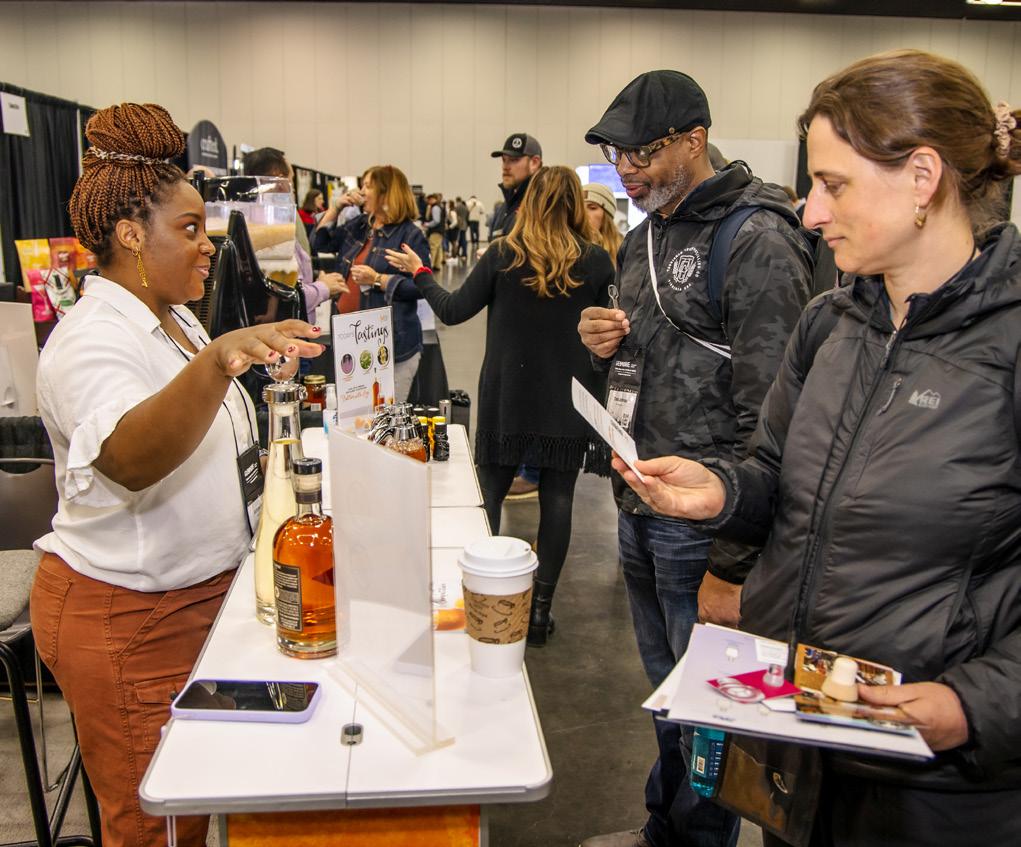

Bring your team and join producers and vendors for the nation’s premier
Don’t miss:
• Nearly 200 Expo Booths
• Distillery 101 Course
• Tucson Distillery & Agave Gardens Tour
• 5K Spirit Stride Fun Run & Walk
• Awards Ceremony Luncheon
• Opening Night Pickleball
• Craft Spirits Grand Tasting
*Pre-convention events on March 9 require additional registration.


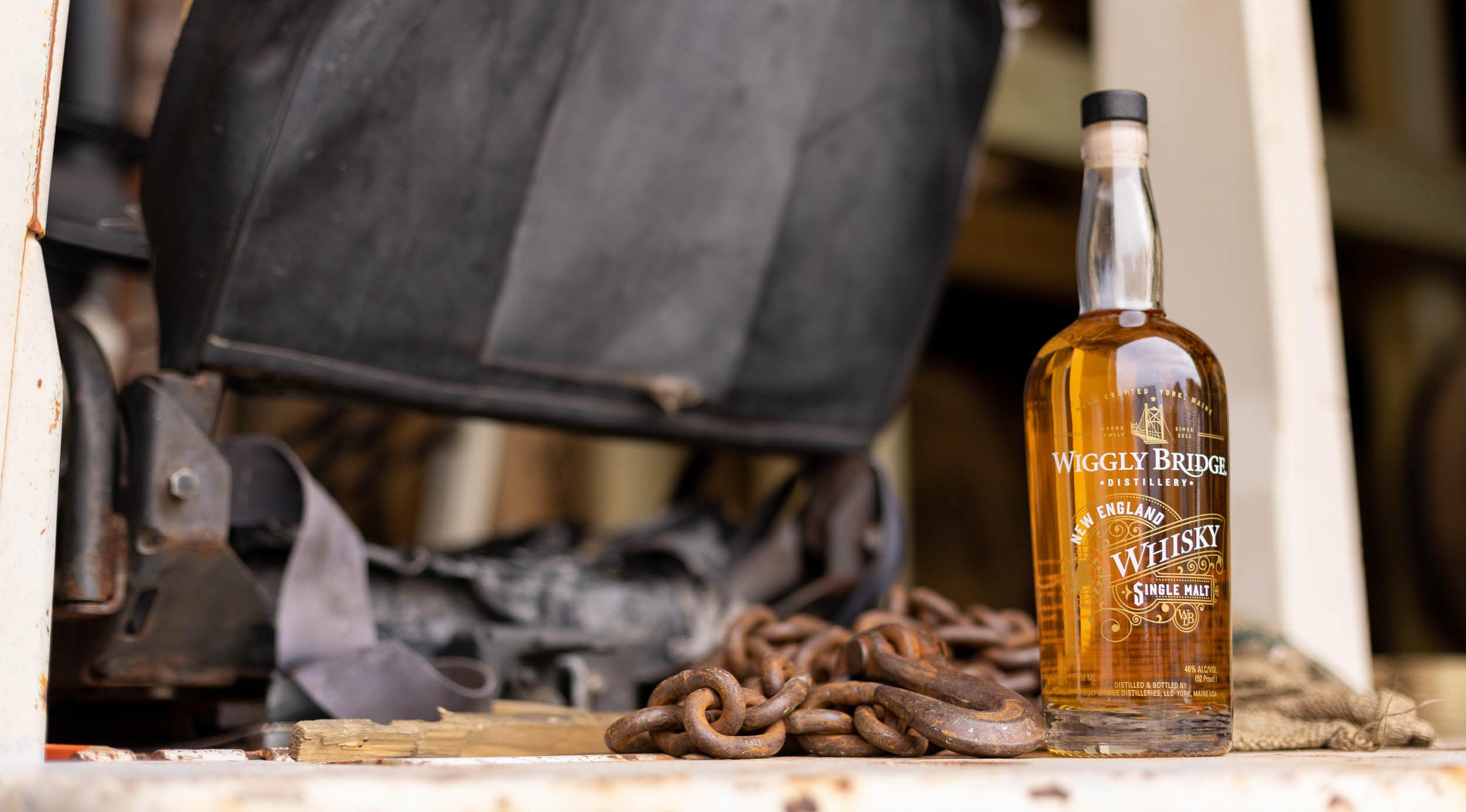

Craft Vodka is Still a Clear Winner
Among lower-priced and better-known brands, small-batch vodka succeeds as a vehicle for unique flavor and stories.
BY KATE BERNOT
Aquavit Finds Its Place
American craft distillers and bartenders are exploring aquavit’s creative potential, drawing curious consumers into its versatile, age-old appeal.
BY COURTNEY ISEMAN
MEMBER SPOTLIGHTS
Getting to Know
ACSA Member Producers
Profiles on Eight Oaks Farm Distillery, Pilot House Distilling and Wiggly Bridge Distillery
DISTILLING DESTINATIONS
Spirits of the Desert
Arizona’s distillers embrace their rugged environment to create spirits that reflect the state’s diverse landscape and culture.
BY JOHN HOLL
BRYSON





56 The Sipping Scene
Exploring the wide world of bars and tasting rooms
FLAVOR TRENDS 58
A New Wave of Aperitifs
From Hugo Spritzes to historic rosolios, lighter, nuanced aperitifs are making their mark on modern palates. BY DEVON TREVATHAN
Kernels of Clarity
Unaged corn whiskey showcases the distiller’s art and craft. BY
JEFF CIOLETTI
2025 Barrel and Wood Trends
Exploring new possibilities with barrels, alternative woods and sustainable practices
LEGAL CORNER
Crossing State Lines
Navigating compliance issues to sell distilled spirits
CRAFT SPIRITS MAGAZINE
CEO, AMERICAN CRAFT SPIRITS ASSOCIATION | Margie A.S. Lehrman, margie@americancraftspirits.org
EDITOR IN CHIEF | Jeff Cioletti, jeff@americancraftspirits.org
SENIOR EDITOR | Jon Page, jon@americancraftspirits.org
ART DIRECTOR | Michelle Villas
MEDIA SALES REPRESENTATIVE | Annette Schnur, sales@americancraftspirits.org
CONTRIBUTORS | Kate Bernot, Maggie Boyd, Lew Bryson, John Holl, Courtney Iseman and Devon Trevathan
AMERICAN CRAFT SPIRITS ASSOCIATION
EDUCATION MANAGER | Kirstin Brooks, kirstin@americancraftspirits.org
DIRECTOR OF MARKETING & MEMBERSHIP | Anna Klainbaum, anna@americancraftspirits.org
ADMINISTRATIVE ASSISTANT | Albab Melaku, albab@americancraftspirits.org
DIRECTOR OF MEETINGS & EVENTS | Stephanie Sadri, stephanie@americancraftspirits.org
ACSA ADVISORS
STRATEGIC COMMUNICATIONS | Alexandra S. Clough, GATHER PR LEGAL | Ryan Malkin, Malkin Law, P.A.
PUBLIC POLICY | Jim Hyland, The Pennsylvania Avenue Group STATE POLICY | Michael Walker, The Walker Group, LLC
ACSA BOARD OF DIRECTORS, 2024-2025 PRESIDENT | Kelly Woodcock, Westward Whiskey (OR) VICE PRESIDENT | Amber Pollock, Backwards Distilling Co. (WY) SECRETARY/TREASURER | Jeff Kanof, Copperworks Distilling Co. (WA)
Jordan Cotton, Cotton & Reed (DC)
Greg Eidam, Sugarlands Distilling Co. (TN)
Becky Harris, Catoctin Creek Distilling Co. (VA)
Adam Polonski, Lost Lantern Whiskey (VT)
Colin Spoelman, Kings County Distillery (NY)
Jaime Windon, Windon Distilling Co. (MD)
EX OFFICIO
Jessica J. Lemmon, Cart/Horse Distilling (PA)
CENTRAL & MOUNTAIN
Tom Bard, The Bard Distillery (KY)
Amber Pollock, Backwards Distilling Co. (WY)
Phil Steger, Brother Justus Whiskey Co. (MN)
Olivia Stewart, Oxbow Rum Distillery (LA)
Mark A. Vierthaler, Whiskey Del Bac (AZ)
Thomas Williams, Delta Dirt Distillery (AR)
ACSA PAST PRESIDENTS
2023-2024 | Gina Holman, J. Carver Distillery 2020-2023 | Becky Harris, Catoctin Creek Distilling Co. 2018-2020 | Chris Montana, Du Nord Craft Spirits 2017-2018 | Mark Shilling, Genius Liquids/Big Thirst 2016-2017 | Paul Hletko, FEW Spirits 2014-2016 | Tom Mooney, House Spirits
CRAFT SPIRITS MAGAZINE EDITORIAL BOARD
PACIFIC
Lucy Farber, St. George Spirits (CA)
Jeff Kanof, Copperworks Distilling Co. (WA)
Kelly Woodcock, Westward Whiskey (OR)
ACSA PAC
Jordan Cotton, Cotton & Reed (DC)
Lew Bryson, Alexandra S. Clough, Sly Cosmopoulos, Kamilah Mahon, Prof. Dawn Maskell, Adam Polonski and Teri Quimby
For advertising inquiries, please contact sales@americancraftspirits.org For editorial inquiries or to send a news release, contact news@americancraftspirits.org
P.O. Box 470, Oakton, VA 22124 © 2025 CRAFT SPIRITS magazine is a publication of the American Craft Spirits Association.
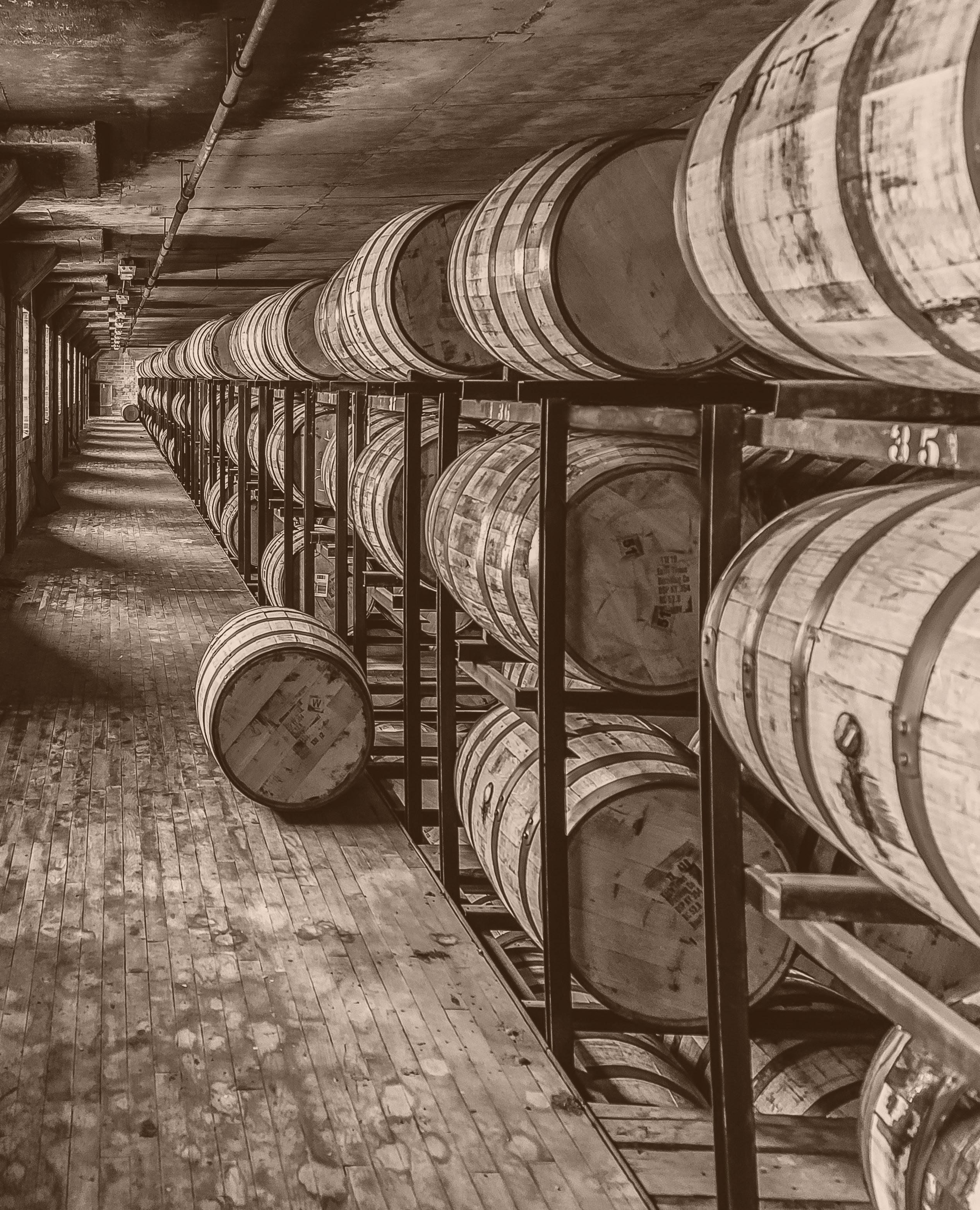

ACSA’s 2025 Convention & Expo is nearly upon us (March 10-12, for those keeping score at home), and I couldn’t be more excited to be heading to Tucson, Arizona, with all of my colleagues and hundreds of members of the craft spirits community. Here are just a few of the reasons why you should be joining us as well.
Since we’ve traditionally held the convention in the colder months, we’ve often had to pack warmer clothes. Our suitcases are likely to be considerably lighter this year, as the average high in southern Arizona during the month of March is around 77 degrees Fahrenheit. It makes for a nice change of pace.
A comprehensive education schedule has long been a cornerstone of the convention and this year’s program is shaping up to be the strongest yet. The agenda features more than 30 hours of education from nearly 40 industry leaders, encompassing a range of topics on three tracks: Production/Safety, Sales/Marketing and Business Leadership. And there will be sessions tailored to all levels of expertise within our industry: Fundamental, Intermediate and Advanced.
And those just starting out in the industry are going to want to get to town a bit early to take advantage of the Distillery 101 pre-convention curriculum. It requires a separate registration fee, but the investment will pay dividends in craft spirits careers for decades to come.
Another of the signature pre-convention events has been the distillery tour and this year is no different. On Sunday, March 9, we’ll board the bus for an all-day tour that includes stops at Whiskey Del Bac, Flying Leap Vineyards and Distillery, Mission Gardens and many others. Concurrently, there will be a separate excursion to Saguaro National Park, featuring a ranger-led tour through the breathtaking desert destination. Both tours require separate admission fees and space is limited. So, don’t sleep on these events!
We’re ramping up the health and wellness activities this year. For a nominal additional fee of $35 (pre-registration required), you can join your peers the morning of Monday, March 10, for the “Spirit Stride” 5K run and walk at Gene C. Reid Park. All skill levels can participate, from leisurely walkers to experienced marathon runners. A race shirt is included in the fee and the event is generously sponsored by Grandstand.
And I’m not just talking about drinks. To officially kick off the convention Monday evening, attendees can grab a paddle and enjoy a little friendly competition on the pickleball courts at Corbett’s. Even if you don’t feel like playing the hottest sport that’s sweeping the nation, there will be plenty of food and drinks to enjoy at the historic landmark. The reception is included in the convention registration fee and all are welcome.
Once again, we’ll be hosting an awards luncheon to present the medals for the 2025 ACSA Spirits Competition and the Craft Spirits Packaging Awards. If you entered either or both of these competitions, you might want to leave some extra space in your bags for some hardware. Even if you didn’t, you’ll want to cheer on your peers as they accept their medals. There’s no extra registration fee required for the luncheon.
The Grand Tasting of spirits traditionally has been one of our most popular events. You’ll get to sample some of the 350 products entered in the 2025 ACSA Craft Spirits Competition on the evening of Wednesday, March 12. You’ll also get to sing (or playfully heckle your friends) during our third-annual karaoke extravaganza. It’s all included in the regular registration fee.
This is the Convention & EXPO after all, and on Monday and Tuesday, March 10 and 11, you’ll get to engage with nearly 200 vendor partners on the trade show floor, showcasing the latest in equipment, ingredients, packaging, technology and services that will help move our industry forward.
That’s about all I could fit in this space. For many more details and to register, head over to americancraftspirits.org.
See you in the sunny Sonoran Desert! ■


Jeff Cioletti Editor in Chief

Lew Bryson has been writing about beer and spirits full-time since 1995. He was the managing editor of Whisky Advocate from 1996 through 2015, where he also wrote the American Spirits column, and reviewed whiskeys. He is currently a Senior Drinks Writer for the Daily Beast, and also writes for WhiskeyWash.com, American Whiskey and Bourbon+. He is the author of “Tasting Whiskey” (Storey Publishing, 2014), a broad survey of the whiskeys of the world, their history and manufacture. He has also written four regional brewery guidebooks.

John Holl is a journalist covering the beer industry. He’s the author of several books including “Drink Beer, Think Beer: Getting to the Bottom of Every Pint” and “The American Craft Beer Cookbook.” He is the co-host of the podcast Steal This Beer, and his work has appeared in The New York Times, The Washington Post, Wine Enthusiast and more. John has lectured on the culture and history of beer and judged beer competitions around the world.

Kate Bernot is a reporter covering beer, food and spirits. She regularly contributes to Sightlines and Craft Beer & Brewing; her work has appeared in The New York Times, The Washington Post, Imbibe and elsewhere. She is a BJCP-certified beer judge and the immediate past director of the North American Guild of Beer Writers. She lives in Missoula, Montana.

Courtney Iseman is an award-winning freelance writer covering craft spirits and beer. Her work has appeared in outlets including The Washington Post, Food & Wine, Punch, VinePair, Wine Enthusiast, Men’s Journal and more. She has been a columnist focusing on drinks as well as local food and beverage happenings for Decibel Magazine, amNew York and i-D, and authored the Beer Tarot Zine for publisher Bean to Barstool.

Maggie Boyd has been a compliance specialist in the alcohol industry for nearly 18 years and is currently senior compliance specialist at Malkin Law, P.A.

Devon Trevathan is a spirits writer and entrepreneur. She has been covering the distilling industry for eight years, with a focus on process and the individuals who make up the independent side of the business. She is the co-founder and co-owner of Liba Spirits, a nomadic distilling company, as well as the co-founder, executive blender and executive sales manager of Trovador Inspirado Rum. Though she is based in Nashville, Devon travels often, distilling in faraway places, speaking on panels, and drinking in the world around her.
The American Craft Spirits Association would like to thank all of our annual sponsors and our key supporters of education. We are grateful for all of your support throughout the year. Interested in becoming a sponsor? Visit americancraftspirits.org/sponsors or contact membership@americancraftspirits.org.










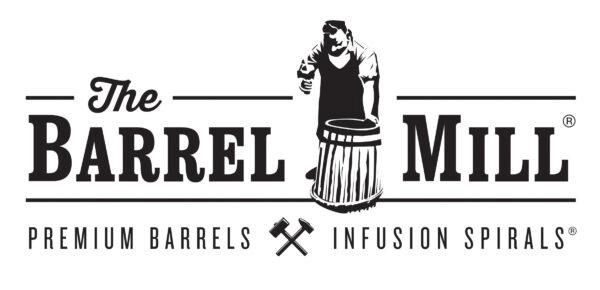












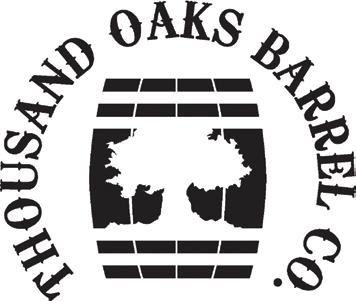

Good Deeds Spirits is proud to announce its second release, Good Deeds Whiskey Batch No. 2. At 90 proof, this release is a blend of WhistlePig Straight Rye (Shoreham, Vermont) and Black Button Bourbon (Rochester, New York), whose recipe was created by an esteemed group of seasoned distillers and STEPUP Foundation alumnus. This 500 bottle release will be sold via Big Thirst, Inc., with profits benefiting the STEPUP Foundation, the diversity and inclusion initiative founded by the American Craft Spirits Association

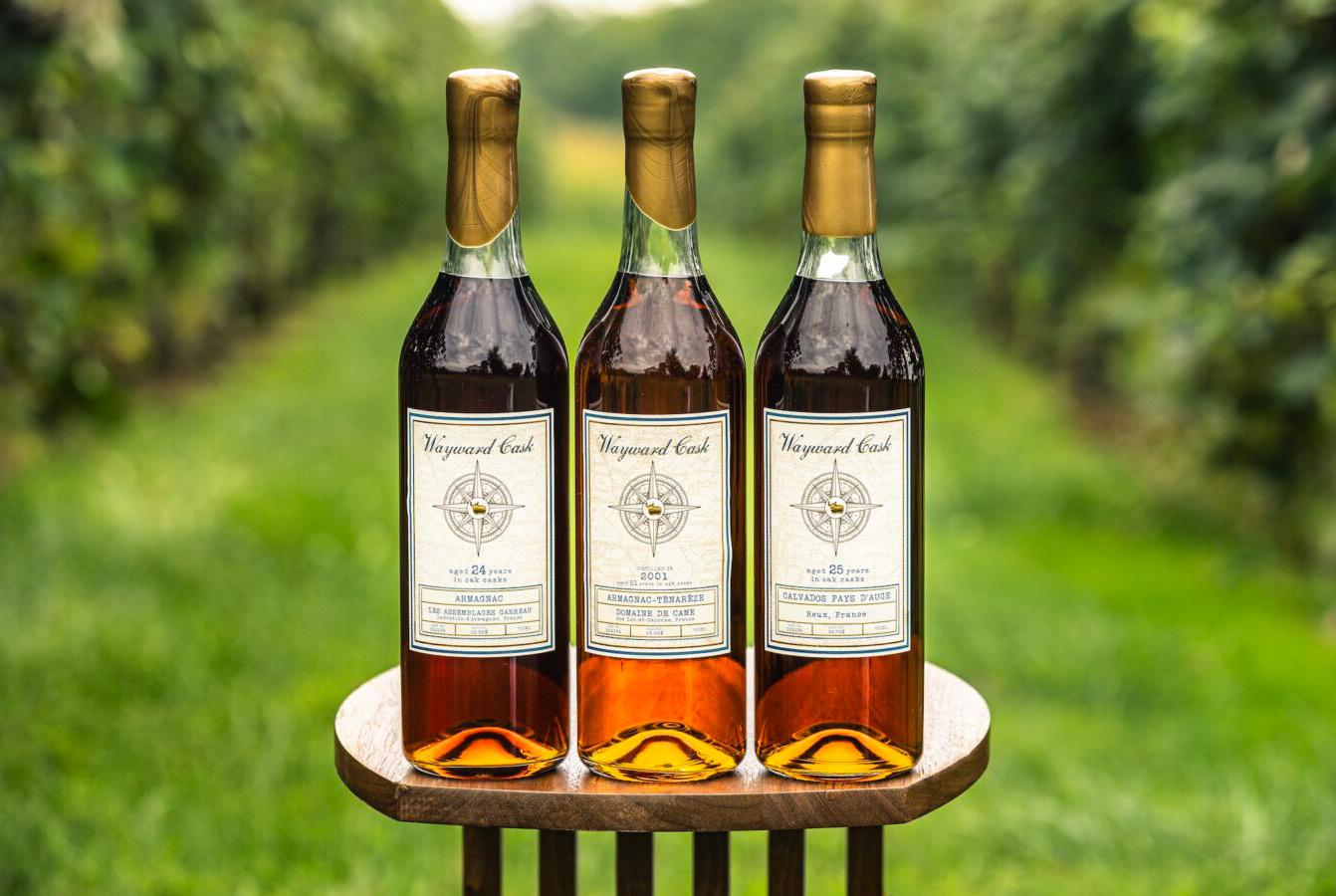
Rolling Fork Spirits is adding a series of exciting new rums and rare single-barrel aged French spirits. The Lost Cask Rum Trio: The Teenage Years includes a 17-year rum distilled in Barbados; a 16-year rum distilled by Ten Can Distillery in Trinidad and a 15-year rum distilled in Jamaica. For Wisdom of Age Rum, Rolling Fork bottled a blended, unaged pot-still rum distilled at the Hampden Distillery in Jamaica. And founders Jordan Morris and Turner Wathen have bottled some rare, aged Armagnacs and Calvados under their Wayward Cask label.

Hopkinsville, Kentuckybased Casey Jones Distillery is marking a decade of American whiskey and moonshine production with the release of a special, limited-edition Founder’s 10th Anniversary Blend
An homage to the distillery’s namesake and master distiller Arlon “AJ” Jones’ grandfather—the formidable Kentucky moonshiner Alfred “Casey” Jones—the Founder’s 10th Anniversary Edition is a unique blend of Kentucky Straight Bourbon Whiskey and Barrel Cut, a proprietary spirit distilled from corn and cane. It is bottled at 103.3 proof.

Town Branch Distillery, the primary distilling operation of Lexington, Kentucky-based Lexington Brewing & Distilling Co. is proud to announce the inaugural release of its Bottled-inBond Kentucky Single Malt Whiskey Archive Series. The 100-proof Town Branch 15-Year Bottled-in-Bond Kentucky Single Malt Whiskey Archive Series Vol. 1 is the oldest bottled-in-bond American single malt whiskey ever made, according to the distillery.
Arnold, California-based Hinterhaus Distilling announced the release of its fourth batch of American Single Malt—Discovery Series. The 92-proof Batch 4 features a malt bill composed of 88% Gallagher’s Best and 12% Pacific Victor from Admiral Maltings Hinterhaus open-air fermented the wash before distilling it and maturing it in a combination of ex-bourbon and ex-wheat whiskey barrels from Speyside Cooperage (Ohio) and Kelvin Cooperage (Kentucky), respectively.
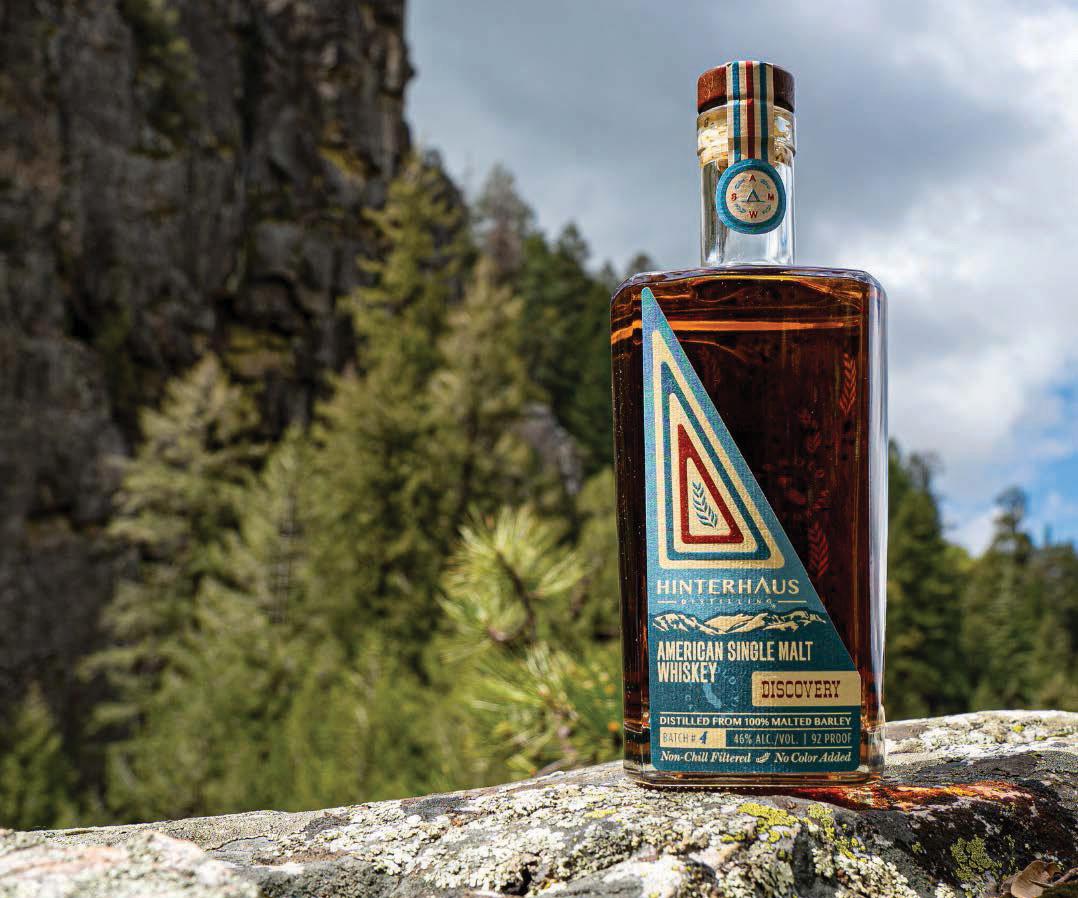

Gig Harbor, Washington-based Heritage Distilling Co. unveiled its latest tribute in the Salute Series: Battle of Iwo Jima: 80th Anniversary Edition, in partnership with the Marine Raider Foundation This exclusive release commemorates the 1945 battle wherein more than 25,000 Marines were wounded and 6,140 gave the ultimate sacrifice in one of World War II’s most historic battles.

River Falls, Wisconsin-based Tattersall Distilling announced the launch of two new exclusive spirits— Seven-Year Bottled in Bond Rye Whiskey and SixYear Bottled in Bond Wheated Bourbon Both releases are 100 proof and represent the distillery’s longest-aged spirits released to date.

Log Still Distillery of Gethsemane, Kentucky, is proud to unveil its latest creation, Faithfully Crafted: The Trinity Blend Bourbon, a testament to the unique and meaningful partnership between the Archdiocese of Louisville and Log Still Distillery. This 90-proof collaboration celebrates the intersection of Kentucky’s rich bourbon-making heritage and the enduring traditions of faith and community.
Swisher, Iowa-based Cedar Ridge Distillery, under the direction of master blender Murphy Quint, has released the fourth in a series of limited-edition expressions of their award-winning American Single Malt, The QuintEssential: Wine Club, First Meeting. At 118.1 proof, this release exclusively features wine-finishing casks: Amontillado Sherry, Tokaji, Moscatel, and Pinot Noir.
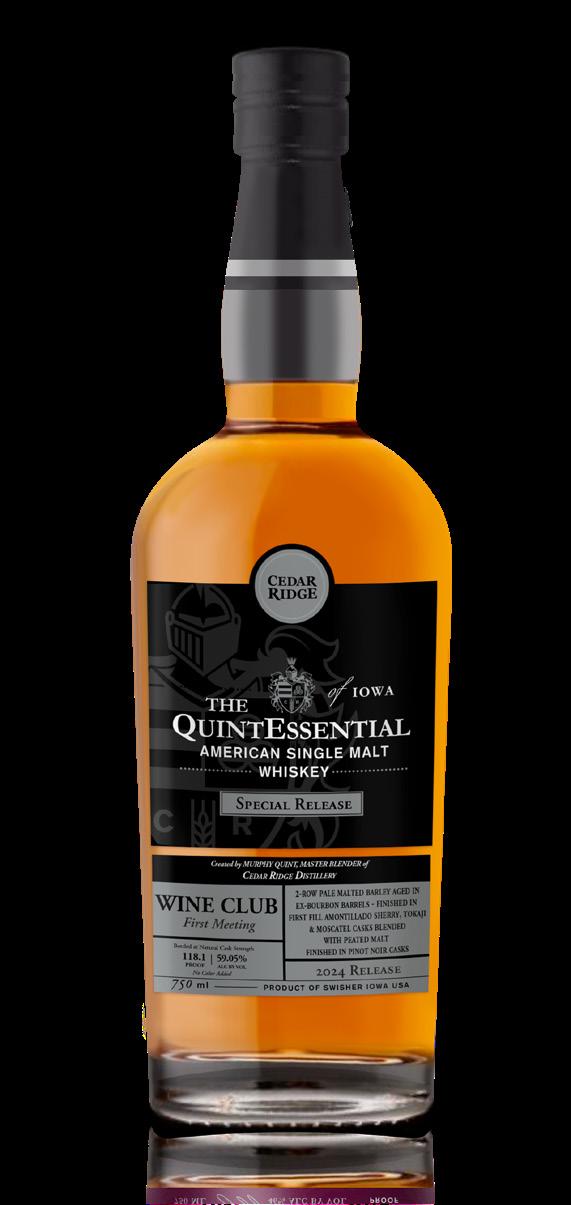
Following his victory on the TV show “Moonshiner’s Master Distiller,” Denver, North Carolina-based moonshiner Big Nick Calo’s signature Peanut Butter Banana Moonshine has now earned the honor of becoming an officially licensed Elvis Presley product. South Mountain Distilling Co. of Connelly Springs, North Carolina, re-released Calo’s moonshine as a collectible series during Elvis’ 90th birthday celebration in Memphis, Tennessee, at the Guesthouse at Graceland.


Long Road Distillers of Grand Rapids, Michigan, has unveiled Uncharted Zero Proof Cocktails, a new line of canned cocktails that challenges the notion of what an alcohol-free beverage can be. The flavors include: Chinotto, a zesty, citrus-forward blend with layers of bitter complexity; Lemongrass Mule, a refreshing twist on a classic, balancing bright lemongrass with warm ginger, Red Amaro Spritz, a bittersweet medley of botanicals, perfect for those who seek balance in every sip; and Lavender Lemonade, a soothing yet vibrant floralforward take on a timeless favorite.

Statesville, North Carolina-based Southern Distilling Co. launched a limited release of Southern Star Bourbon Finished in Honey Barrels. This cask-strength bourbon, bottled at 106.8 proof, was finished in a honeydrenched barrel for a year, which delivers hints of toffee, fruit, walnut, and a delicate sweetness that balances warm, peppery spice.
Grand Rapids, Michigan-based Eastern Kille Distillery announced the return of Steenstra’s Old Fashioned Steenstra’s Windmill Cookies recently transitioned ownership to Eastern Kille co-owner, Brandon Voorhees. Voorhees is the grandson of Harold & Joanne Voorhees who operated Steenstra’s for the past 30 years. Their cookie, the Windmill Cookie, inspired the Steenstra’s Old Fashioned.


Hidden Barn Bourbon is releasing its latest offering in its Series One expression, titled Slow Fade, named for its sweet, slow fade on the finish. The 106.5-proof Slow Fade is the 10th release under the Series One line, the bourbon brand started by master blender Jackie Zykan in 2022 in partnership with Neeley Family Distillery of Sparta, Kentucky.

Patricia Green Cellars of Newberg, Oregon, announced the release of two new whiskeys to its whiskey portfolio.
Patty Green Whiskey Distillers Full Pint Barley (85 proof) and Gazelle Rye (100 proof) are the newest whiskeys made with brandy using smoke-tainted grapes saved from the 2020 wildfires.

Seattle-based The Pathfinder proudly unveils its latest concoction: The Pathfinder Negroni, a ready-to-drink non-alcoholic Negroni. This meticulously crafted, noncarbonated elixir captures the essence of the classic Negroni cocktail, offering intrepid imbibers a convenient companion for spontaneous outings and convivial gatherings alike.

Author: Tracee J. Craft
Publisher: Independently published
Release Date: Dec. 17
This book is a soulful mixology journey inspired by the timeless vibes of R&B. This recipe book features over 50 handcrafted cocktails and mocktails, each paying homage to the songs and artists that defined generations. From smooth slow jams to party-starting anthems, every drink is crafted to capture the essence of R&B music.

Author: Sarah Gualtieri
Publisher: Insight Editions
Release Date: Jan. 14
From the critically acclaimed hit television show on HBO comes a cocktail book designed to bring the elegant resort experience to your home. With 60 cocktails to take you from Hawaii to Sicily to Thailand, an exotic escape awaits you in every glass. In this official cocktail guide, savor the sophistication and elegance with each drink filled with a hint of tropical paradise and fantasy.

Author: Philip Greene
Publisher: Union Square & Co.
Release Date: Feb. 25
This book is an informative celebration of one of the most beloved cocktail categories: sours. It’s a collection of 100 cocktails and demonstrates the irresistible allure of citrus and sours when paired with spirits. The fascinating history and lore of iconic and universally beloved beverages such as the Daiquiri, Sidecar, Margarita, Whiskey Sour and Cosmopolitan are mixed with recipes to teach you how to make each of these classic drinks. Every aspect of these legendary drinks—including special ingredients and all the ways to riff on this delicious and versatile flavor palette—is explored in this essential collection.
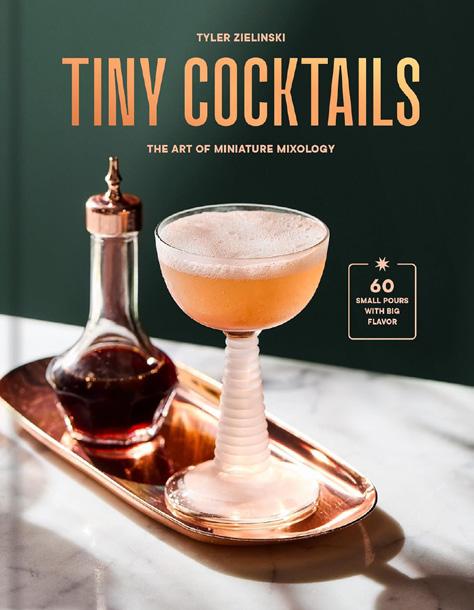
Tiny
Author: Tyler Zielinski
Publisher: Clarkson Potter
Release Date: Feb. 25
“Tiny Cocktails” offers a unique and creative approach to mixology for those who want to savor delicious cocktails without overindulging. The recipes showcase smaller drinks with big flavors—an ideal way to explore new flavors and refine your mixology skills without making a full-drink commitment. Each drink comes in around 3-6 ounces, with about half the alcoholic punch of a full-sized cocktail. There are predinner libations to welcome guests, caffeinated cocktails in small doses so they don’t keep you up at night, and over-the-top indulgences that make a delicious treat.
In December, the U.S. Alcohol and Tobacco Tax and Trade Bureau (TTB) announced its final rule designating American Single Malt Whiskey as its own category, the culmination of a multi-year effort spearheaded by the nation’s independent spirits producers.
The final rule was effective on Jan. 19.
“As an independent craft spirits producer of American single malt, we applaud TTB for its final ruling,” says Kelly Woodcock, partner and general manager at Westward Whiskey (Portland, Oregon) and president of the American Craft Spirits Association’s (ACSA) board of directors. Westward was also a founding member of the American Single Malt Whiskey Commission (ASMWC). “This will be a game changer in the way we are able to market our products, both at home and abroad. American single malt is expensive and challenging to make and this designation helps consumers better understand why.”
“Recognizing American single malt whiskey as its own standard of identity offers the country’s small craft spirits producers a means to further differentiate themselves in the crowded marketplace,” says Margie A.S. Lehrman, CEO of ACSA. “Thanks to the efforts of countless ACSA volunteer members, along with the tireless work of the American Single Malt Whiskey Commission and allied members of the trade, TTB makes clear the distinctiveness of single malt whiskeys produced by the nation’s small, independent spirits manufacturers.”
The adopted criteria for American single malt whisky specify that the product be a type of whisky that is mashed, distilled and aged in the United States; is distilled entirely at one U.S. distillery; is distilled to a proof of 160 or less; is distilled from a fermented mash of 100 percent malted barley; is stored in oak barrels (used, uncharred new or charred new) with a maximum capacity of 700 liters; and is bottled at not less
than 80 proof. In addition, the criteria allow for the use of caramel coloring as long as its use is disclosed on the product label. The regulation will also allow the use of the term “Straight” for an American single malt whisky that is aged for at least two years.
TTB proposed the new standard of identity in response to petitions and comments submitted by several distillers and the ASMWC. TTB finalized the petitioned-for standard of identity with some changes to reflect comments received in response to the related notice of proposed rulemaking. All documents and comments related to this new standard of identity proposal are posted at regulations.gov within Docket No. 2022–0007.

The U.S. Alcohol and Tobacco Tax and Trade Bureau (TTB) announced it is authorizing 15 new standards of fill for distilled spirits containers. The amendments in the final rule, which was published on Jan. 10, provide more flexibility to industry members and offer consumers more purchasing options.
Distilled spirits industry members may now use the following new standards of fill: 187, 250, 331, 350, 355, 475, 500, 570, 700, 710, and 945 milliliter sizes and 1.5, 2, 3, and 3.75 liter sizes. These are in addition to those that had already been approved, and all standards of fill for distilled spirits are now approved for cans and containers other than cans.
This is a big win for producers of ready-to-drink (RTD) cocktails such as Tenth Ward Distilling Co. in Frederick, Maryland. The distillery uses a 250-mL can for its RTDs that is packaged in a four-pack and therefore approved as a 1-L package. The can was strategically chosen for numerous reasons, but to get certificate of label approvals (COLAs) before the new rule, the distillery also had to submit and print additional labels and adhere them atop the four-pack PackTech rings. Between the cost of printing and labor, Tenth Ward founder Monica Pearces said the extra cost amounted to about $1 per four-pack.
“We are pumped! We do need to go through the process of updating our labels and making the transition, but the whole team is super excited about this,” says Pearce. She added that the new rule also opens up the ability to create a mix pack of RTD flavors.
In 2022, the American Craft Spirits Association petitioned the TTB to add 250 mL to the list of approved standards of fill for distilled spirits. In the standards of fill for wine, 250 mL was already an approved size.

Tales of the Cocktail Foundation (TOTCF) announced Charlotte Voisey as its new executive director. A respected and established leader in the global spirits and hospitality industry, Voisey brings nearly two decades of experience, award-winning achievements, and a deep passion for spirits and education to her new role.
Reporting to CEO Eileen Wayner and the board of directors, Voisey will oversee the Foundation’s mission to educate, advance and support the global drinks community, ensuring that TOTCF remains a driving force for innovation and collaboration within the industry.
“I am excited to welcome Charlotte to the Foundation’s leadership team,” said Wayner. “Her unique career in this industry ensures that the work we do will drive thought leadership and anticipate and respond to the needs of our colleagues across the industry. With the additional support of Charlotte, I look forward to expanding the reach of the Foundation to consumers and creating new business development initiatives that continue to celebrate and support the drinks industry.”
Prior to the executive director appointment, Voisey served as the overall chair of the Spirited Awards from 2016 to 2024. In 2010 her contributions were recognized when she won a Spirited Award for Best American Brand Ambassador. Further, she’s served as a seminar moderator annually since 2007, offering meaningful contributions to Tales’ education program.
“I greatly admire the incredible work Eileen, the board of directors, the Foundation team, and global committees have done over the last seven years and don’t take lightly the responsibility to represent the needs of the industry at large in this position,” said Voisey. “Tales has been close to my heart since I first attended in 2006. I have witnessed firsthand the incredible catalyst Tales has been for the industry during two decades of seismic evolution in the cocktail and spirits world. With the support of our tremendous global committees, I look forward to taking the Foundation through the next chapter of educating, advancing, and supporting bartenders and our broader community.”
Voisey’s career is also marked by her tenure at William Grant & Sons, where she led the globally respected brand ambassador program from 2006 to 2024, managing a team of 100 professionals across 40 countries. Her role helped redefine how spirits brands connect with the hospitality industry. In 2019, she further cemented her legacy as an educator by becoming an associate partner of the esteemed B.A.R. 5-Day Program.

Voisey had her innovative cocktails featured at world-renowned establishments such as New York’s PDT and London’s Dorchester Hotel. Recognized with numerous accolades, including UK Bartender of the Year, Mixologist of the Year and a silver medal at the World Female Bartender Championships, Voisey has also captivated mainstream audiences with appearances on “TODAY” and the Food Network, solidifying her status as a leading voice in the world of cocktail craftsmanship.
For more information about Tales of the Cocktail Foundation and its initiatives, please visit talesofthecocktail.org. Tales of the Cocktail will take place in New Orleans July 20-25.
The Federal Trade Commission (FTC) announced in December that it sued the largest U.S. distributor of wine and spirits—Southern Glazer’s Wine and Spirits, LLC—alleging the company violated the RobinsonPatman Act, harming small, independent businesses by depriving them of access to discounts and rebates, and impeding their ability to compete against large national and regional chains. This loss of competition ultimately harms consumers on choice and price.
The FTC’s complaint alleges that by selling wine and spirits to small, independent “mom and pop” businesses at prices that are drastically higher than what Southern charges large chains—with dramatic price differences that provide insurmountable advantages that far exceed any real cost efficiencies for the same bottles of wine and spirits—Southern engaged in anticompetitive and unlawful price discrimination.
Under the Robinson-Patman Act, it is generally illegal for sellers to engage in price discrimination that harms competition by charging higher prices to disfavored retailers that purchase similar goods. The FTC’s case filed seeks to ensure that businesses of all sizes compete on a level playing field with equivalent access to discounts and rebates, which means increased consumer choice and the ability to pass on lower prices to consumers shopping across independent retailers.
“When local businesses get squeezed because of unfair pricing
practices that favor large chains, Americans see fewer choices and pay higher prices—and communities suffer,” said Chair Lina M. Khan. “The law says that businesses of all sizes should be able to compete on a level playing field. Enforcers have ignored this mandate from Congress for decades, but the FTC’s action today will help protect fair competition, lower prices, and restore the rule of law.”

Since at least 2018 and continuing today, Southern has repeatedly discriminated in price between disfavored independent purchasers—which include neighborhood grocery stores, local convenience stores, and independently owned wine and spirits shops—and favored large chain purchasers of wine and spirits, such as Total Wine & More, Costco, and Kroger, the FTC’s complaint states.
In 2023, Southern generated roughly $26 billion in revenues from wine and spirits sales to retail customers, making it the 10th largest privately held company in the country.
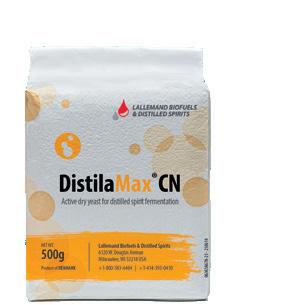

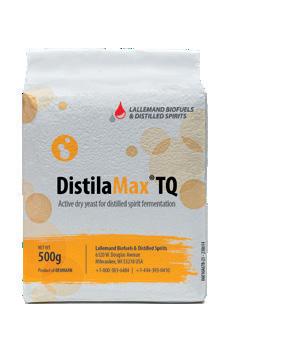



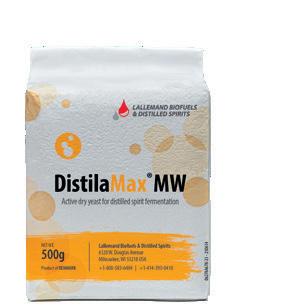

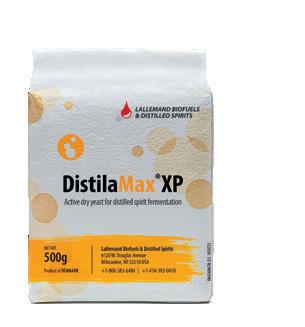



The Kentucky Distillers’ Association (KDA) recently announced that Ken Lewis has been elected chair of the 144-year-old non-profit trade group that unites, promotes, and protects the signature Kentucky Bourbon and distilled spirits industry.
Lewis, founder of New Riff Distilling, began his term as chair beginning Jan. 1, and will serve through December. He succeeds Jessica Pendergrass, general counsel and chief compliance officer for Heaven Hill Distilleries, who is finishing her second turn as chair.
“It is an honor to serve as chair of the KDA. I’m proud to have been a part of all the work KDA has done over the years to grow our industry into a $9 billion economic engine,” said Lewis, who retired in 2024 as president and CEO of New Riff and is now its operating owner.
“As I enter this new leadership role, I have eyes wide open to the opportunities and challenges our industry will face in the coming months and years,” said Lewis. “We’ve always found success when we work together as one distilling family, and I look forward to building upon that legacy.”
KDA president Eric Gregory, who is finishing his 17th year leading the organization, said he looks forward to working alongside Lewis and the entire board as they continue to build upon the strategic plan to strengthen the KDA as the Worldwide Voice for Bourbon.
“We are blessed to have a visionary and engaged board of directors that has perfectly positioned the KDA and our members to confidently advocate for Kentucky Bourbon and American Whiskey on a global scale,” Gregory said.
Alongside Lewis, the board also named Gigi DaDan, general manager of Louisville Distilling Co., as vice chair; Kaveh Zamanian, founder, whiskey maker & CEO of Rabbit Hole Distillery, as secretary; and Chris Morris, master distiller emeritus at Brown Forman Corp. as treasurer.


After a decade of steady, intentional growth, Newport, Kentucky-based New Riff Distilling is announcing availability in all 50 states, with orders now making their way to retailers all over the country.
“Since our founding in 2014, we’ve strived to become one of the world’s great small distilleries—and we’re excited to bring our passion and product to more people, provide consistent availability and tell our story to a larger audience,” said president Mollie Lewis.
Over the years, New Riff has expanded availability, reaching more than 30 states in 2024. Offering product in every state is a major milestone, said chief sales officer Rawnica Dillingham.
“Nationwide distribution is a momentous step forward for New Riff and a testament to the deliberate growth and quality-first approach we’ve championed since day one,” Dillingham said.
“We’re looking forward to sharing our passion and award-winning products with whiskey lovers across the country while staying true to our mission of crafting exceptional spirits with integrity.”
New Riff’s core products will be available at retailers across the country. Those products include Bottled-in-Bond Bourbon, Bottled-in-Bond Rye, Single Barrel Bourbon, Single Barrel Rye, 8-Year-Old Bourbon, 8-Year-Old Rye, and 6-Year-Old Malted Rye Whiskey, as well as the distillery’s Kentucky Wild Gin Bourbon Barreled.

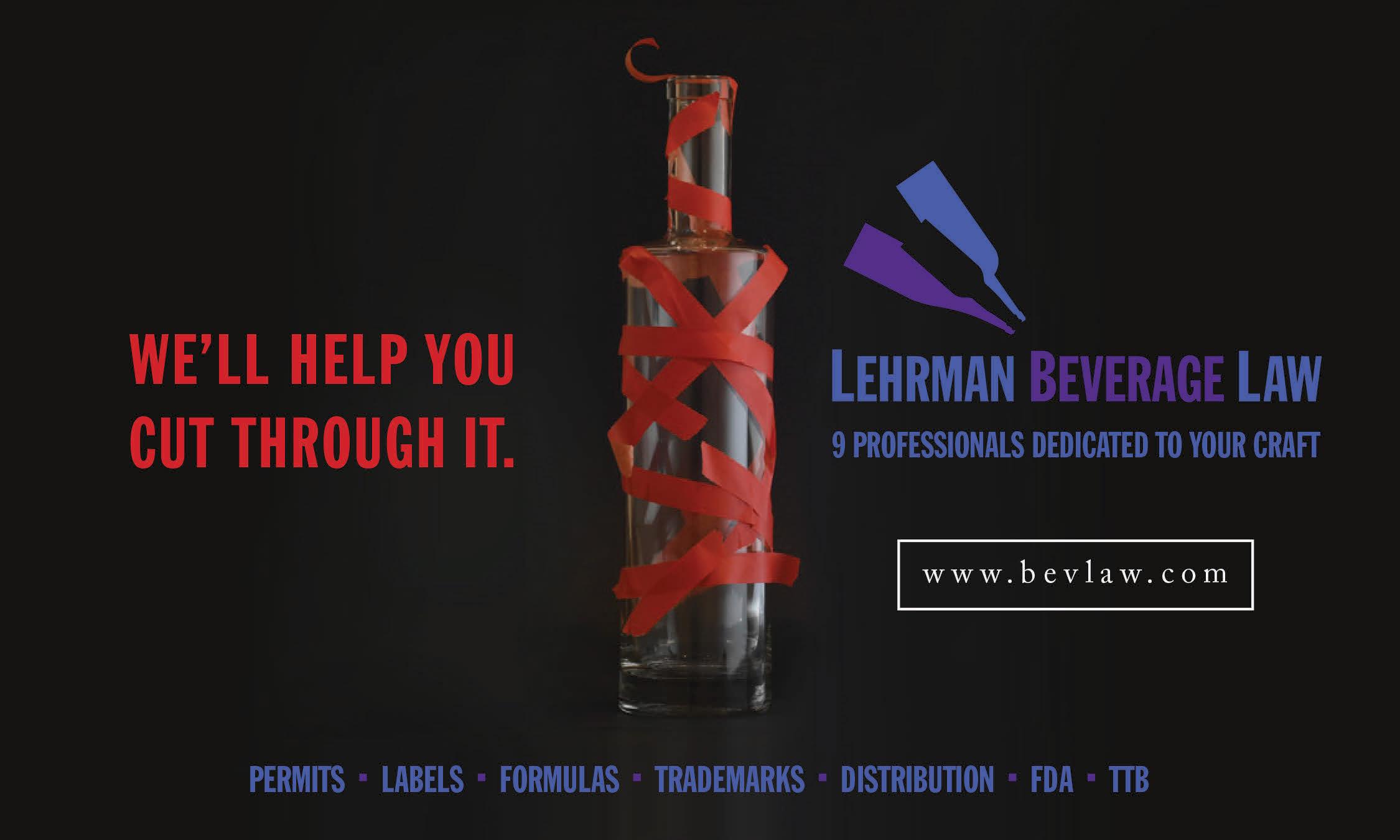
The National Honey Board assembled an expert panel of judges to create a definitive list of the Best Honey Whiskeys and Bourbons in North America. The blind tasting evaluated each product based on its aroma, taste, finish and use of honey to create a complex and exceptional spirit.
The tasting, which was hosted in Louisville, Kentucky, named Hochstadter’s Slow & Low Rock & Rye from the Cooper Spirits Co. as the Best Honey Whiskey and Bourbon in the United States. The 84-proof spirit has a straight rye whiskey base with the addition of rock candy, honey, aromatic bitters and navel oranges. From its citrus nose to its slightly sweet honey taste, this straight rye whiskey was flavorful but perfectly balanced, the judges’ notes stated.
The complete list of the Best Whiskeys and Bourbons with Honey:
1. Hochstadter’s Slow & Low Rock & Rye, The Cooper Spirits Co.
2. American Honey Sting, Wild Turkey Distilling Co.
3. Cooper’s Mark Golden Colony Honey, Cooper’s Mark Whiskey Co.
4. Trapline Rock & Rye, Glacier Distilling Co.
5. Jack Daniel’s Tennessee Honey, Jack Daniels Distillery
6. Honey Run, Golden Beaver Distillery
7. Catoctin Creek Hot Honey Rye, Catoctin Creek Distilling Co.
8. Oak & Eden Wheat & Honey, Oak & Eden
“As the flavored whiskey category continues to grow, we wanted to recognize the flavor that started it all: honey,” said Catherine Barry, National Honey Board vice president of marketing. “Despite honey’s now longstanding use in flavored whiskeys and bourbons, it’s amazing to see a new generation of distillers use the flavor to add complexity, smooth floral notes and bold, spicy finishes.”

Following its announcement last summer, Raise the Bar Mentorship Alliance, the trade mentorship program presented by Shelbyville, Tennessee-based Uncle Nearest, Inc., announced its inaugural cohort of mentees. The diverse group of bartenders from across the country were hand-selected for the program by Lucia Creed, head of trade advocacy at Uncle Nearest, and Sarah de Sousa, director of mentor development, with the help of the program’s mentor team. To be eligible, applicants needed to be working bartenders with at least two years of bartending experience, a completed application, and a letter of recommendation from another member of the industry.
Raise the Bar Mentorship Alliance, an initiative created to honor the legacy of Nearest Green, the first known African American master distiller, was designed to offer mentorship, guidance and support to individuals across all demographics, with a focused commitment to fostering a truly diverse cohort of mentees and championing representation in the spirits industry. With the announcement of the mentees, the program is ready to enter its mentorship phase, pairing these talented individuals with industryleading mentors to help them shape their professional goals, develop long-term projects to positively impact the bar community, and foster a more inclusive future for the industry.
“Raise the Bar Mentorship Alliance is about more than just guiding our mentees—it’s about empowering bartenders—both mentees and mentors—to be the change-makers and innovators who will shape the future of the bar
industry,” said Creed. “We are deeply committed to providing these individuals with the support they need to make a lasting impact, not just within the industry at-large, but also within their communities.”
The majority of mentees were intentionally selected from areas outside traditional ‘major market’ cities, where access to guidance from influential figures is less readily available. This approach aims to connect a diverse network of industry leaders with individuals in these regions, fostering growth and opportunity in emerging or underserved markets.
To learn more, visit raisethebar.org

Townsend, Tennessee-based Company Distilling announced the upcoming opening of its third location in Lynchburg. Scheduled to open this spring, the new location will provide whiskey enthusiasts with another must-visit destination while exploring Tennessee’s rich whiskey culture.
The Lynchburg location will feature a tasting room experience where visitors can savor Company Distilling’s celebrated whiskeys, including the Straight Bourbon Whiskey Finished with Maple Wood, Straight Rye Whiskey Finished with Cherry Wood, and Straight Tennessee Whiskey Finished with Apple Wood.
“Lynchburg has such a strong distilling heritage; we’re honored to contribute to that legacy,” said Jeff Arnett, co-founder of Company Distilling. “We look forward to creating a space where people can come together to share stories, enjoy a quality cocktail and truly connect. It’s about gathering and celebrating the spirit of community.”
Recently, the distillery also announced that its products are now available at ABC Fine Wine & Spirits locations throughout Florida. This marks a significant milestone in Company Distilling’s expansion, bringing its spirits to a broader audience.
“We are thrilled to bring Company Distilling’s award-winning whiskies to shelves across the entire state of Florida,” said Dave Larue, executive vice president of sales for ABC Fine Wine & Spirits. “At ABC, we are dedicated to sourcing the most unique and exceptional spirits from across the country. We’re excited to work with Jeff Arnett on bringing his flagship whiskies to our guests.”
“ABC Fine Wine & Spirits gives us an incredible opportunity to share our passion for crafting exceptional whiskies with the discerning consumers of Florida,” said Arnett. “We believe that our spirits, rooted in tradition and innovation, will resonate with ABC’s customers, and we look forward to being part of their celebrations and gatherings.”

Distilled 7X through nearly 600 feet of distillation, our impurity-free grain neutral spirits will provide a superior base that will never impede your product’s taste profile.

Contact us about our updated 2025 rates. Shipping options include rail, tanker, tote, and drum.



BY LEW BRYSON
Back before I went freelance, I worked for a guy who hated consultants. “They’ll look at your watch and tell you what time it is, then send you a bill before the day’s out,” he said, more than once. The implication was that you already have all the tools you need to do your job; why pay someone to do it for you?
Hard to believe a guy who thought like that was an executive-level manager. He was also overruled on a consistent basis by our technical and creative people, who knew damned well the value of consultants.
Do you? Or do you want to look at your own watch? Before you do, are you sure your watch is keeping accurate time? Are you checking the time in your own office, or in your supplier’s office, in Scotland, or China? Is the watch in 24-hour notation, is it a.m. or p.m.?
You know all that when you look at your watch— hell, it’s probably a smart watch and already told you—but do you know it for everything? Maybe you need to hire a brain, hire some experience, but you only need it for the length of setting up a project, or to streamline your supply chain, or design new labels, or re-do your accounting. Hiring a consultant fits those bills.
(This is not a thinly-veiled advertisement for Lew Bryson Consulting. There is no such business; the only industry consulting I do is right here, every issue.)
If you have a job for a consultant, the first thing you want to do is to figure out the scope of the job, the parameters that they will work within, and the deliverables: what is the goal, and what will the consultant’s product look like?
You have to be pretty precise with this, and it may take a while to get it right. That guy I worked for? One of the first things I did when I came on board was to cancel a consulting contract that had ballooned in size (and cost) because my predecessor had written a madly vague set of deliverables. The consultant wasn’t so much taking advantage of it as they were equally confused, and flailing to meet the terms. Clear contracts, with mutually agreed goals, make for good consulting. Finding the right consultant once you’ve defined your needs is equally important. You want someone who’s experienced in the field, who’s actually done what you need (or something very similar), not someone who’s just out of school. Hire someone who has their own watch, as it were; maybe a couple of watches.
Get their references, ask for testimonials, all that old-school stuff. A consultant has to pass the sniff
test; do they feel right for your company?
On the other hand … maybe what you need is someone you wouldn’t hire. One of the values of consultants is that they can give you an outsider’s perspective, a look at your operation through other eyes.
There are solid financial reasons to hire consultants, too. You only pay for what you need; they’re not on payroll, they’re hired guns. They come in, assess the problem (because if they just take what you think is the problem at face value, they’re not doing the best job), consider solutions, deliver their report … and they leave. Neat and tidy.
And maybe when they deliver that report, it’s not a solution that actually fits what you want to do. It happens. It could be because the contract wasn’t clear, or you simply don’t want to do what might look like the right or most expedient thing to do, for a variety of potentially valid reasons. But don’t shelve it. Study it, because chances are good that there’s something in there you can either use, or jump off from. Get value from the investment.
You might want to hire a consultant when you’ve got a temporary gap in your staff. Say your master distiller suddenly decides to leave; you can quickly hire a consultant who will keep things running while you search for the right permanent replacement.
Or maybe you have a continuing need for something, like graphic design, or payroll, but not enough for a full-time hire. Plenty of consultants will take on those parts of jobs to make up their whole employment, and you don’t have to go through the hiring process.
If you already use consultants, good! Maybe you’ll find something useful in my next column. But if you’ve got a small operation, chances are pretty good that if you’re not using some kind of consultancy, you’ll need to at some point. Make the most of it. Expertise is an incredibly valuable commodity. Go to the consultant market, and buy what you need. ■

Lew Bryson has been writing about beer and spirits full-time since 1995. He is the author of “Tasting Whiskey” and “Whiskey Master Class.”


If you have a job for a consultant, the first thing you want to do is to figure out the scope of the job, the parameters that they will work within, and the deliverables: what is the goal, and what will the consultant’s product look like?
America’s top craft distillers are headed to the heart of the colorful Sonoran Desert this March 10-12. Bring your team and join producers and vendors for the nation’s premier gathering of craft spirits professionals at the 12th annual American Craft Spirits Convention & Expo.
Educational sessions and social gatherings planned by craft distillers, for craft distillers, make this an event unlike any other. For those that want to make meaningful connections, get up to date on policy issues that impact market access, and encounter the latest products and services offered by beverage alcohol vendors, we invite you to join us.
In our strongest education lineup to date, you can expect actionable insights from more than 30 hours of education from nearly 40 industry leaders. Our educational programming is selected by ACSA’s education committee, composed of ACSA craft spirits members from around the country—those who understand the challenges facing craft spirits distilleries. Visit our website to see the entire program.
The convention is open to all in the industry! Exhibitors are encouraged to take advantage of educational programming. Register today to invest in your success in the coming year and beyond.


Entering the craft spirits industry or adding members to your team? Join us for this intensive two-day course led by experienced industry experts and offered each year before our convention. This year’s course will be held March 9 and 10, 2025, in Tucson, Arizona. Explore key topics including equipment and material selection, flavor chemistry and biochemistry, distillery safety practices, the nuances of tasting rooms, navigating distributor relationships, assembling an effective sales team, mastering distillery finance, and much more! Special thanks to our course sponsor, Lallemand.
It’s been a hard year for craft spirits, with lots of challenges ahead. Do you want to help solve them? Join ACSA’s Board of Directors!
Members of the ACSA Board of Directors are critical to modernizing the craft spirits industry. Throughout a three-year term, each member shares a common goal of carrying out ACSA’s mission to elevate and advocate for the community of craft spirits producers.
The voting membership will elect five board seats in March 2025. Now is the time to identify candidates! Make sure your membership is current so you can vote. If you’re not yet a member, consider joining today so you can help shape how the industry moves forward.

In early January, then-U.S. Surgeon General Vivek Murthy issued an advisory calling alcohol a leading preventable cause of cancer. The advisory suggested that a label on alcohol-containing beverages should include a warning about the risk of cancer associated with alcohol consumption. The statement catapulted media attention with renewed focus on alcohol consumption. ACSA plans to release a broader statement in the future. In response to an article published in The Wall Street Journal, ACSA CEO Margie A.S. Lehrman submitted the following response, which was published by the Journal on Jan. 10.
Response from Margie A.S. Lehrman, Chief Executive Officer, American Craft Spirits Association I agree with Allysia Fenley’s “No, Moderate Drinking Won’t Give You Cancer” column January 6 regarding Surgeon General Vivek Murthy’s recent warning about a link between drinking alcohol and cancer.
The timing of Dr. Murthy’s announcement comes late into his tenure, while also coinciding with both New Year’s Eve and the kickoff of Dry January. This leads me to wonder, was this politically timed for maximum publicity, rather than the real advancement of cancer prevention? Suddenly, four years into his tenure, the present Surgeon General has come to the realization that alcohol must contain a cancer warning. Perhaps his staff or the neo-prohibitionists pushing this course of action failed to remind him that every bottle of alcohol already carries two warnings, a blanket statement that “the consumption of alcohol may cause health problems” and an additional warning that pregnant women should not consume alcohol. Certainly the inclusion of a health warning would include cancer.
The National Cancer Institute (NCI) already informs that age, obesity, lifestyle, smoking and heredity factors can influence cancer. NCI already urges us to “limit” alcohol intake, a notion the spirits industry—which today includes more than 2,000 small, independent distilleries across the country—has taken seriously and helped to promote for three decades. Responsible consumption has long been part of our mission, and we fully support the continuation of these efforts.
If the Surgeon General believes that he will make progress in reducing risks for cancer through a labeling campaign, perhaps he should focus then on leading risk factors, like diet and sun exposure. Would he be better served promoting health warning labels on packaged cookies, bacon, and other ultra-processed or sugary foods?
Public health officials should have learned their lesson that extreme positions lead Americans to ignore their warnings rather than heed them. The present warnings and ample public information on alcohol are already more than enough to inform Americans about alcohol consumption and their own health.
In its ongoing effort to evolve and expand its service to the craft spirits community, ACSA is pleased to announce the appointment of Emily Pennington as Chief Operating Officer.
In this newly created position, Pennington will work closely with CEO Margie A.S. Lehrman to address the key issues facing the craft distilling industry, including the organization’s continued push for modern market access and work defending its community of independent craft distillers in today’s challenging alcohol landscape. As the architect behind the development of industry publication Wine & Spirits Daily and industry education platform Park Street University, Pennington will guide ACSA’s mission critical operations on membership, industry outreach, and sustainability to further the organization’s growth. While at Park Street, she was instrumental in executing the Craft Spirits Data Project, the collaborative study between ACSA and Park Street, which annually reports on the economics of the craft spirits industry.

Pennington has been in the alcohol industry for nearly 15 years, specializing in content strategy and organization management. She has demonstrated capabilities in driving operational excellence and strategic implementation, along with extensive experience working to provide guidance and solutions to thousands of small distillers around the world.
Margie A.S. Lehrman, CEO, ACSA, added, “I am thrilled to welcome Emily into this newly-created leadership position. I have had the privilege of knowing her since I joined ACSA a decade ago, both during her tenure as a seasoned drinks industry journalist and in her previous role launching and leading the deep education offerings at Park Street, and I cannot wait to support her as she leverages the same passion and work ethic to carry ACSA into a new era.”
“Together and with Emily’s support, ACSA will remain focused on critical issues to ensure our small business manufacturers, who are intricately connected to their local hospitality and agricultural communities, will keep pace with modern society, with support that a national trade group can offer. That will also include a renewed interest in creating best-in-class membership offerings to continue to set the organization apart from other industry groups.”
Pennington added, “It is a tremendous honor to join Margie, the Board of Directors, ACSA’s advocacy partners, and the organization’s staff to work together to make a meaningful impact on the current and future community of craft distillers. I am ready to tackle the challenges facing our community in 2025 alongside the extremely dedicated staff at ACSA.”

Among lower-priced and better-known brands, small-batch vodka succeeds as a vehicle for unique flavor and stories.
BY KATE BERNOT
Among the rainbow of spirits made by craft distillers, vodka is the invisible water droplets: mostly colorless and long perceived as flavorless, but an indispensable and often overlooked part of the whole. It therefore presents a unique sales and brand positioning challenge—even nearly five years after the Alcohol and Tobacco Tax and Trade Bureau (TTB) removed the “without distinctive color, aroma, taste, or color” verbiage from its official definition.
Unlike whiskey or rum, vodka is rarely sipped straight. To the average drinker—who is almost always mixing vodka with something else—the spirit is defined by its neutrality, and most familiar, national brands largely taste interchangeable. And, unlike tequila or bourbon, vodka doesn’t enjoy the same cultural cachet. Why, then, would consumers choose to spend a premium on a craft vodka when less expensive choices abound?
The answer lies in what have always been the bedrocks of small distillers: storytelling and creativity. Whether it’s using local ingredients, branding the vodka to reflect its geography, or simply being a small business that drinkers can feel good about supporting, small distillers have found that vodka is a blank canvas onto which they must write their stories. Austin, Texas-based leviathan Tito’s Vodka has spent three decades convincing drinkers that American craft vodka is a category worth paying a premium for; today, smaller brands can step into that lane with identities of their own.
“Most people don’t drink our vodka just neat, but if you did, I think you’re getting a true taste of Three Oaks, Michigan,” says Bill Welter, founder of Journeyman Distillery in— obviously—Three Oaks, Michigan. “We really believed strongly in storytelling, and our Red Arrow Highway Vodka is a great opportunity to tell the story of our distillery and of our local places using local ingredients.”
Vodka remains a stalwart of the U.S. liquor market, making up about 30% of overall
“Most people don’t drink our vodka just neat, but if you did, I think you’re getting a true taste of Three Oaks, Michigan.”
—Bill Welter of Journeyman Distillery
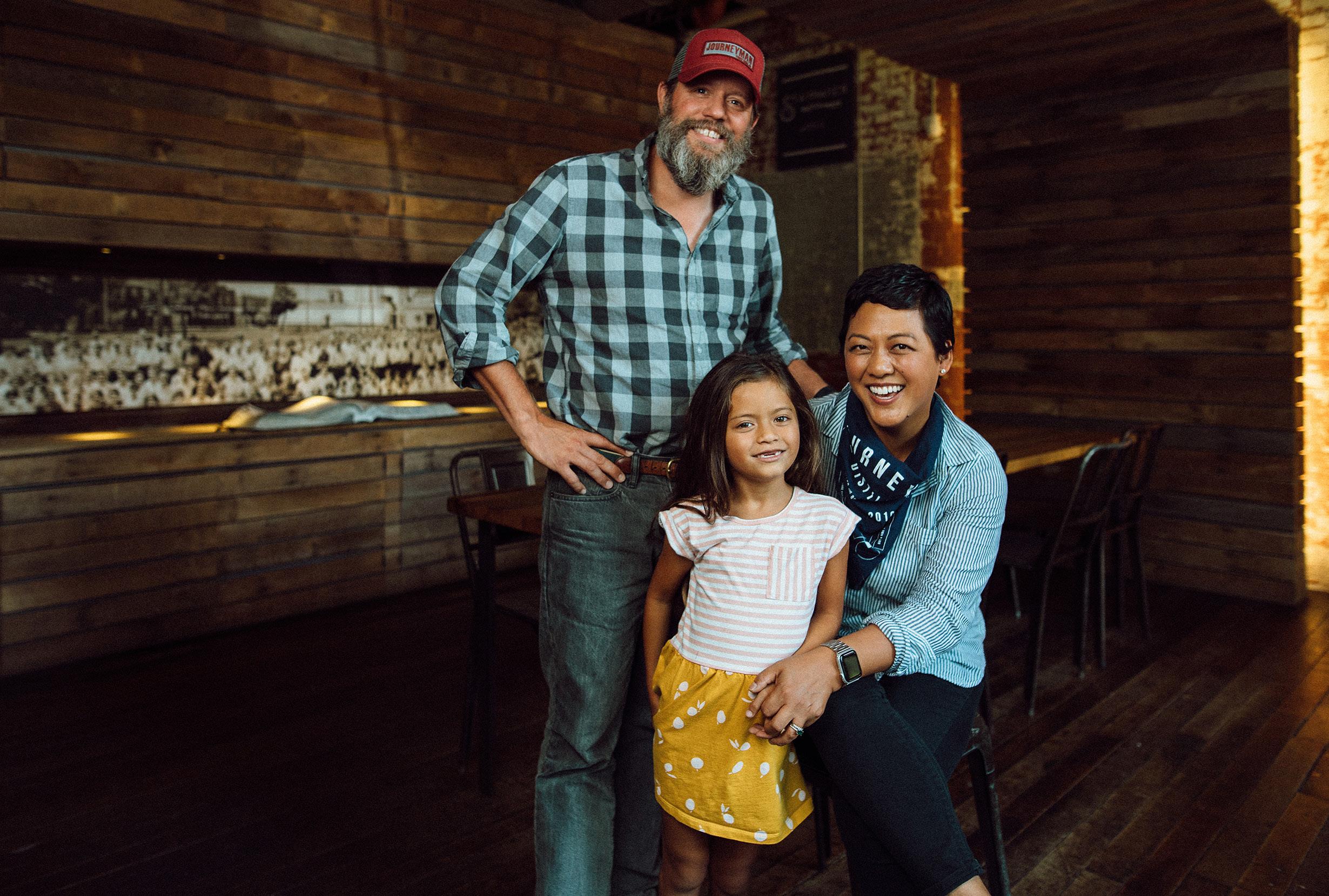




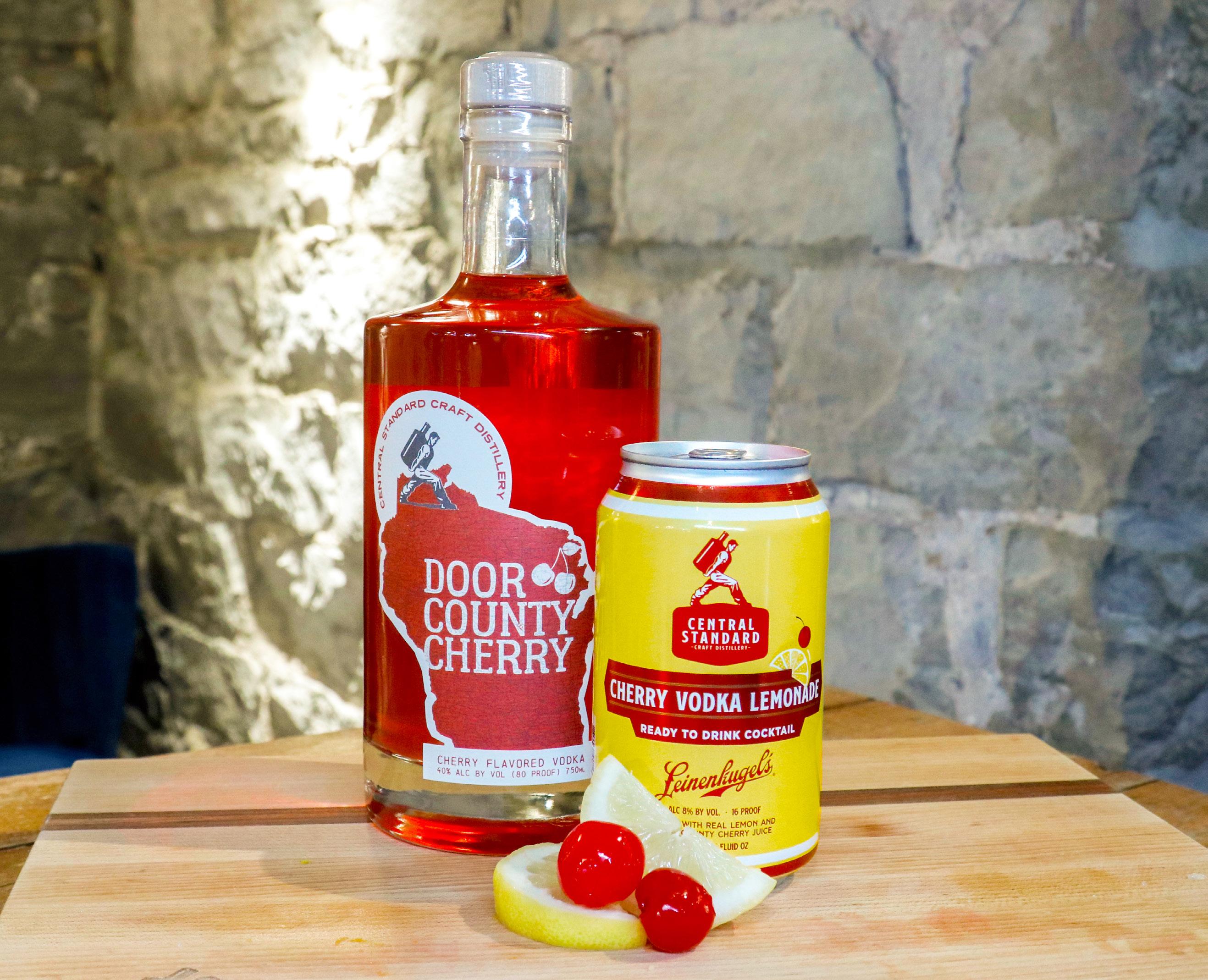
volumes last year, but its sales growth has underperformed the broader spirits category. Looking more closely, however, there are bright spots for craft distillers: Data from the Distilled Spirits Council of the United States shows sales volumes of high-end premium and super premium vodka were higher in 2023— the most recent year for which data is available—than they were pre-pandemic in 2019, while volumes for value and premium vodka were down. Drinkers who have the money and inclination to spend more on top-tier products are driving the bulk of growth for vodka brands. Since 2021, vodka has also been the number-one base for spirits-based cocktails, having surpassed tequila for that title.
“A lot of consumers are still very open and interested in trying brands that fit their lifestyle and that have some resonance to their personality or their location,” says Russell Pareti, chief marketing office for Philadelphiabased Stateside Vodka, which also makes the fast-growing Surfside brand of vodka-based hard teas and lemonades. “When you take quality and match it up with a story and you present that to consumers, I have found that that is a winning combination.”
Craft distillers can continue to quietly win with their vodka brands, using novel ingredients, places, and histories as points of distinction in a crowded and price-sensitive category.

“A lot of consumers are still very open and interested in trying brands that fit their lifestyle and that have some resonance to their personality or their location. When you take quality and match it up with a story and you present that to consumers, I have found that that is a winning combination.”
—Russell Pareti of Stateside Vodka

Conveying a sense of place in a spirit that’s still widely considered neutral can be tricky, but distillers have found ways—both subtle and bold—to connect where vodka is made to the liquid itself. At Journeyman, Michigan water and wheat take center stage in the distillery’s Red Arrow Vodka. Out of the still at 190 proof, the vodka is diluted to 90 proof not with reverse osmosis water, but with unchlorinated water from Three Oaks’ aquifer. For its distillate, Journeyman uses all Michigangrown wheat from certified organic, pesticidefree farms. The combination, Welter says, allows the distillery to tell a real story about place, ingredients and value-added agricultural products. And, for the very discerning vodka drinker, he says the water and wheat do have distinct characteristics. “It is a little heavier on the palate. It’s got a weight to it and the flavor is primarily neutral, but there’s a buttery creaminess,” he says.
Ingredients also help tell the story of Journeyman’s Field Vodka, one of the three spirits the company made in partnership with Chicago’s Field Museum to celebrate the natural history museum’s 125th anniversary. Each spirit made use of an ingredient introduced at the World’s Columbian Exposition in Chicago in 1893, the year the Field Museum was founded; the vodka is distilled from 100% Bloody Butcher red corn. Welter says this partnership is in line with Journeyman’s ethos of honoring history and tradition. When visitors see the distillery’s locations—one in an 1800s corset and buggy factory, one in an early 20th century building—it connects Midwest history to the vodka in their glass.
“People hear the story and I think there’s a pride of place where people feel like they’re drinking something from the World’s Fair in 1893, and it’s this idea of telling history, telling that story,” he says. That “pride of place” is reinforced by multiple touchpoints: the distilleries’ buildings, the labels on its bottles, the ingredients, and crucially, the flavors and textures they taste in the vodkas themselves.
The Difference Isn’t Clear
Local agriculture also takes center stage in the best-selling vodka from Central Standard Craft Distillery in Milwaukee, Wisconsin. Door County is located about three hours’ drive north along the peninsula from Milwaukee, and in the Midwest, the county is synonymous with tart cherries. Door County cherries from Seaquist Orchards, along with honey from nearby Indian Summer Farms, impart a singular flavor and color to Central Standard’s
Door County Cherry Vodka. Since launching in 2018, that sweet-tart, fruited vodka has become one of the distillery’s top products. Though Central Standard is best known for its whiskeys, Door County Cherry Vodka accounts for almost 30% of total sales. With its vibrant pink hue, the vodka stands out on a shelf or in a bartender’s cocktail.
“We’re always looking to do different things, but we want to do it in a purposeful way that makes sense and connects to our brand,” says Jim Kanter, chief commercial officer at Central Standard. “It’s got to be about that Midwestern outdoor refreshment and gathering with friends.”
The distillery didn’t fully anticipate the level of success that Door County Cherry Vodka would have. In its own way, the vodka anticipated the trend toward RTDs: Because it already has a flavor, it’s easily mixed with just one other liquid, such as lemonade, to create a quick but interesting cocktail. Bartenders love it, too, because it adds a memorable layer of flavor to what would otherwise be straightforward cocktails, like a Moscow Mule.
It partially inspired the distillery’s launch of Pour Ready cocktails like Rocket Pop (Door County Cherry Vodka and blue raspberry) and Door County Cherry Vodka Mule (Door County Cherry Vodka, ginger, and organic lime juice), available in 750mL and 1.5 liter bottles. And in June, Central Standard announced a partnership with Wisconsin-born beer brand Leinenkugel’s for an 8% ABV canned Cherry Vodka Lemonade made with Door County Cherry Vodka and Leinenkugel’s lemonade-based summer shandy. Sales of these cherry vodka products have had ripple effects for the rest of Central Standard’s portfolio. Selling large volumes of Door County Cherry Vodka has created economies of scale that have reduced costs of goods for the distillery’s unflavored Standard Issue vodka, allowing Central Standard to lower its on-the-shelf pricing from $27.99 a few years ago to roughly $19.99 today. In many ways, the cherry vodka has become a true innovation driver for Central Standard, pushing the distillery into new formats, like canned cocktails, and new price tiers. “We’re taking flavors and what’s working [with Door County Cherry Vodka] and applying it to different packaging and different experiences,” Kanter says.
Even craft distilleries know there are limits to what drinkers will spend on vodka. Bars and restaurants can be even more price sensitive when it comes to the vodka they’ll
use in standard cocktails. So it took some creative engineering on the part of High Bank Distillery in Columbus, Ohio, to craft a vodka that could retail on par with or for less than Tito’s, and be affordable enough for bars to use as a well vodka. The distillery’s established High Bank Vodka retails for about $18.99 for a 750mL, but the (614) Vodka—named for Columbus’ area code—launched typically retails for less than $15. Launched last May in partnership with local publishing company (614) Media, this vodka aims to compete with some of the largest brands in the U.S.
“What we’ve really focused on is how do we steal Tito’s market share in our markets?” says High Bank co-founder and distillery head Adam Hines. “High Bank Vodka is a little more elevated. … (614) Vodka is still a quality vodka, but we call it Ohio’s house vodka, something you can always have around.”
How does High Bank achieve this price point? Creative ingredients. The distillery is open about sourcing grain neutral spirit in bulk, then distilling it with Ohio-grown apples. The apples provide a link to local agriculture—and a tax incentive. Under Ohio laws, products using fruit grown in-state receive a reduced tax rate compared to those that don’t. For High Bank, apples in the product results in a reduced tax liability, a lower cost to drinkers, and a point of differentiation.
“If we were to make everything from scratch like we do for our bourbon, we’re going to have to charge $24 to $27 for that bottle of vodka and nobody’s paying that amount of money,” Hines says. “The [grain neutral spirit and apples] allows us to get a great price for the consumer, but it allows us to tell that local story.”
So far, on-premise accounts have proven easier to convert than customers shopping at Ohio liquor stores. WIth a hospitality group it requires just one conversation, which can result in hundreds or thousands of cocktails made with (614) Vodka. For individual customers shopping at retail, that conversion happens one by one. “It’s one thing to talk to a restaurant group and say, ‘Hey, you should really look at using our vodka instead of Tito’s.’ It’s local. And the price point is the same on it. We can switch people over to that,” Hines says. “But from a retail standpoint, you can’t tell that story every time.”
Luckily, High Bank operates three highvolume restaurants, including a 250-seat restaurant adjacent to its distillery. Those restaurants all have full bars that stock nonHigh Bank products, and until a year ago, those restaurants all carried Tito’s. When the
decision was made to switch all vodka to High Bank’s brand, Hines says consumer pushback was non-existent, proving that drinkers aren’t particularly loyal to that market leader. Even when customers ordered a Tito’s and soda by name, they proved willing to try a vodka that was made locally. That’s good news for craft distillers, who often have deeper roots in their communities and more chances for face-toface customer interaction than multinational brands do. Drinkers value local brands, even when they may not be able to articulate the nuances that distinguish one vodka from another. For many, choosing a craft vodka is about supporting small businesses and identifying themselves as “in the know” when
it comes to spirits. For Stateside, that word of mouth spread by fans who discover the brand on-premise has proven critical.
“There’s a lot of people out there that are looking for the next great vodka brand that they can tell their friend about and really use it as a badge,” Pareti says. “Instead of maybe what has been their more traditional order, they’re like, ‘Hey, let me get a Stateside espresso martini for me and my buddy.”
Stateside and other craft vodka brands may not enjoy cultish followings like rare bourbon, but they have a regular place in drinkers’ rotations in a way that many more specialty products don’t. When it comes to accessible, affordable bottles that customers can reach

For many, choosing a craft vodka is about supporting small businesses and identifying themselves as “in the know” when it comes to spirits
for on a regular basis, there’s no better way to remain on drinkers’ minds—and bar carts— than by making their new favorite vodka. ■
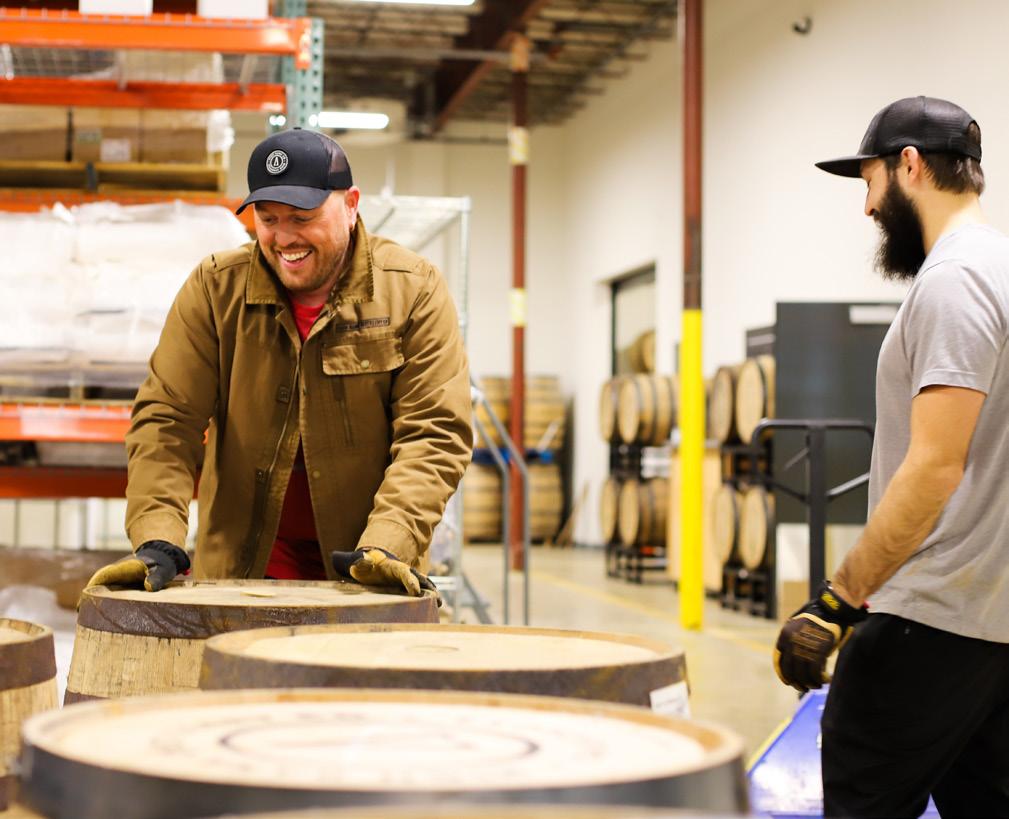


American craft distillers and bartenders are exploring aquavit’s creative potential, drawing curious consumers into its versatile, age-old appeal.
BY COURTNEY ISEMAN
Aquavit has been a staple spirit in Scandinavia for centuries, but it’s just beginning its journey in American craft distilling. Its growth is slow but steady, fueled by distillers realizing creative potential in the blank canvas its relatively low-key category guidelines offer, as well as by intrigued bartenders riffing with the spirit on cocktail menus and by today’s more well-traveled consumer being likely to have some awareness of it.
“We made more [aquavit] this year than we normally do,” says Paul Werni, owner of 45th Parallel Distillery in New Richmond, Wisconsin. “If I get a distributor from outside of our region, that’s what they want. Five years ago they wanted my bourbon, but now they have five bourbons where they’re at, so now they’re interested in aquavit.”
“For years, it’s been a slow trickle,” says Tom Greene, founder of Edgewood, Washington’s NightSide Distillery. “I was making it out of love, not for margins, but all of a sudden, I can’t keep it on shelves.” Aquavit tends to appear where there are Scandinavian populations, like in the Midwest and near NightSide in Tacoma. But more Americans
are becoming better acquainted with international spirits like aquavit lately because of increased travel, notes Ralf Loeffelholz, owner and head distiller of Dampfwerk Distilling in St. Louis Park, Minnesota. And bartenders, their fingers on the worldwide spirit pulse, see aquavit as an exciting new opportunity for experimentation, in turn bringing followers into the fold.
“It’s still a struggle in many ways to get the category out there, but bartenders know what it is, and it’s pretty solidly on the radar of cocktail enthusiasts,” says Robyn Cleveland, co-founder and distiller at Norden Aquavit in Chelsea, Michigan. “I couldn’t say the same seven years ago. You’d walk into bars and people wouldn’t know what it was.”
While the most common motivation to make aquavit for a distiller in the United States tends to be some connection to Scandinavian culture, these distillers quickly recognize opportunities for innovation. It’s the American craft beverage way, after all, to push boundaries. When it comes to American-made aquavit, the category is growing on a foundation of tradition plus forward-thinking creativity.

To be considered aquavit in the United States, the spirit must feature caraway or dill as its primary botanical. Increasingly, American distillers choose to adhere to slightly stricter European guidelines, mandating that caraway or dill is the main flavor through distillation, not infusion. It should be 37.5 percent ABV or higher, and, Cleveland notes, can’t have more than 15 grams of sugar per liter of solids. From there, there’s flexibility for bases, other flavors, and barrel-aging. A primary goal for American distillers is to maintain aquavit’s hallmark characteristics while also making it their own and creating something approachable for the American consumers, whether that’s bringing in familiar flavors or rounding out some of the spirit’s more intense notes.
Loeffelholz achieves this by blending in bourbon. He has a long history with aquavit, having been born and raised in Germany, where the spirit is also a popular tradition in the north. He knew he wanted to make aquavit when Dampfwerk opened in 2016, but took time to fine-tune how his would be different, and how it would appeal to an
“Five years ago they wanted my bourbon, but now they have five bourbons where they’re at, so now they’re interested in aquavit.”
— Paul Werni of 45th Parallel Distillery on distributors’ interest in aquavit

American palate.
“Bourbon softens the profile,” Loeffelholz says. “One of the most famous aquavits is Linie, who puts their aquavit in barrels and ships them back and forth across the equator, which makes it softer, milder. As a craft distiller, I don’t have the time or means to ship aquavit across the equator. … To simulate barrel-aging, I use 10% bourbon.” The bourbon meets the aquavit in a final blending step. It brings in woodiness and breadiness, combining with the caraway for a spiced, rounded caraway bread character, which gets complexity from angelica and coriander and brightness from citrus.
In River Falls, Wisconsin, Tattersall Distilling has also gotten creative on how to merge this Scandinavian spirit with American tastes. In addition to a traditional aquavit they finish in rye whiskey barrels for at least 16 months, they also craft Toasted Coconut Aquavit. Head distiller Bentley Gilman says this variation, now a Tattersall staple, was born as an ingredient for tasting room cocktails—cofounder Dan Oskey began experimenting with fat-washing liquors, and the team saw what Gilman calls an “interesting juxtaposition, with this very Scandinavian, northern thing, mixed with this tropical flavor … it’s familiar but also out of left field.”
For the limited amount needed for those on-site cocktails, Gilman toasted the coconut and fat-washed the aquavit with it. But as more customers began asking for the toasted coconut aquavit in bottles, Tattersall strategized a more efficient method, working with a producer to extract toasted coconut into a natural flavor. After distillation, Gilman rests the aquavit briefly in oak, and then adds extracted toasted coconut back in with a touch of light demerara sugar. With a perfect marriage of baking spices, botanicals, citrus and the coconut, the aquavit has become a great entrance point for bars and restaurants. “When we taste a bartender on [it], immediately they’ll want to tinker and make drinks with it,” Gilman says.
Building New Aquavits with Barrel-Aging Barrel-aging is the most popular path for a distiller to craft a signature aquavit. In terms of the Scandinavian aquavit blueprint, only Norwegian aquavit must be barrel-aged, and specifically in oak casks, typically sherry. Branching out with barrels is an opportunity for experimentation.
Emily Vikre, co-founder and CEO of Duluth, Minnesota’s Vikre Distillery, is a dual citizen of the United States and Norway.
She grew up around family who would enjoy aquavit, as well as the different types made in Scandinavia. “You can get holiday aquavit, aquavit to pair with fish, aquavit to pair with dried lamb,” she explains. When establishing Vikre, she knew she wanted to represent these styles most Americans are unfamiliar with, in a distinctly Vikre way.
“I thought, let’s make two styles, one a bit more Danish … which tends to be not aged … and one a bit more Norwegian,” Vikre says. “From the start I decided to riff on the botanicals, toning down the caraway people might expect from Linie or Aalborg … and do a more celebration-style aquavit with citrus and spices.” Instead of sherry barrels, Vikre settled on cognac barrels as an homage to her aunt who loved cognac after holiday dinners— cognac is also beloved across Norway, she explains. Aquavit aged in cognac barrels felt like a “very insider flavor combination.” After a year in those barrels, the Voyageur Aquavit is caraway-forward with softer licorice notes of fennel and aromatic baking spices, ginger, cardamom and orange peel. “The cognac really softens the spices so they’re less bright, deeper and toastier, layered over grape blossom and plum blossom,” Vikre says.
45th Parallel has a collection of aquavits, including the kinds of holiday and celebration aquavits that inspired Vikre. Werni initially began producing them for Mike McCarron, who had fallen in love with dill-forward Danish aquavit as a ski instructor in Iceland and would launch the aquavit brand Gamle Ode—today, the collection is considered a collaborative line within 45th Parallel’s portfolio. There’s Dill Aquavit and its variation, Alderen, aged for several years in white zinfandel barrels, which Werni says softens the dill and brings in a familiar white wine flavor. Holiday Aquavit features dill, juniper berries, orange, mint, allspice and caraway, and is aged in red zinfandel barrels. For Holiday on Rye, Werni blends the red zin barrel-aged Holiday with rye barrel-aged Holiday. Celebration Aquavit, with additions of vanilla bean and star aniseed, is finished in both Holiday and bourbon barrels, and Celebration on Rye brings back in the blend of rye barrel-aged Celebration.
Greene says the NightSide team knew right away they wanted their aquavit to be barrel-aged. NightSide Aquavit starts with the distillery’s go-to clear spirit neutral base of cane sugar and apples—because this combination is so highly fermentable, it provides a clean foundation for the aquavit’s botanicals to shine, with no lingering tastes

“In Scandinavia, as with many places, people look at something old and traditional and associate it with a thing that belonged to their grandparents, or as stale, or with bad decisions around the holidays. In America, bartenders and distilleries don’t have those associations [with aquavit]. It’s unique and esoteric, and they’re using it in creative ways.”
Emily Vikre of Vikre Distillery
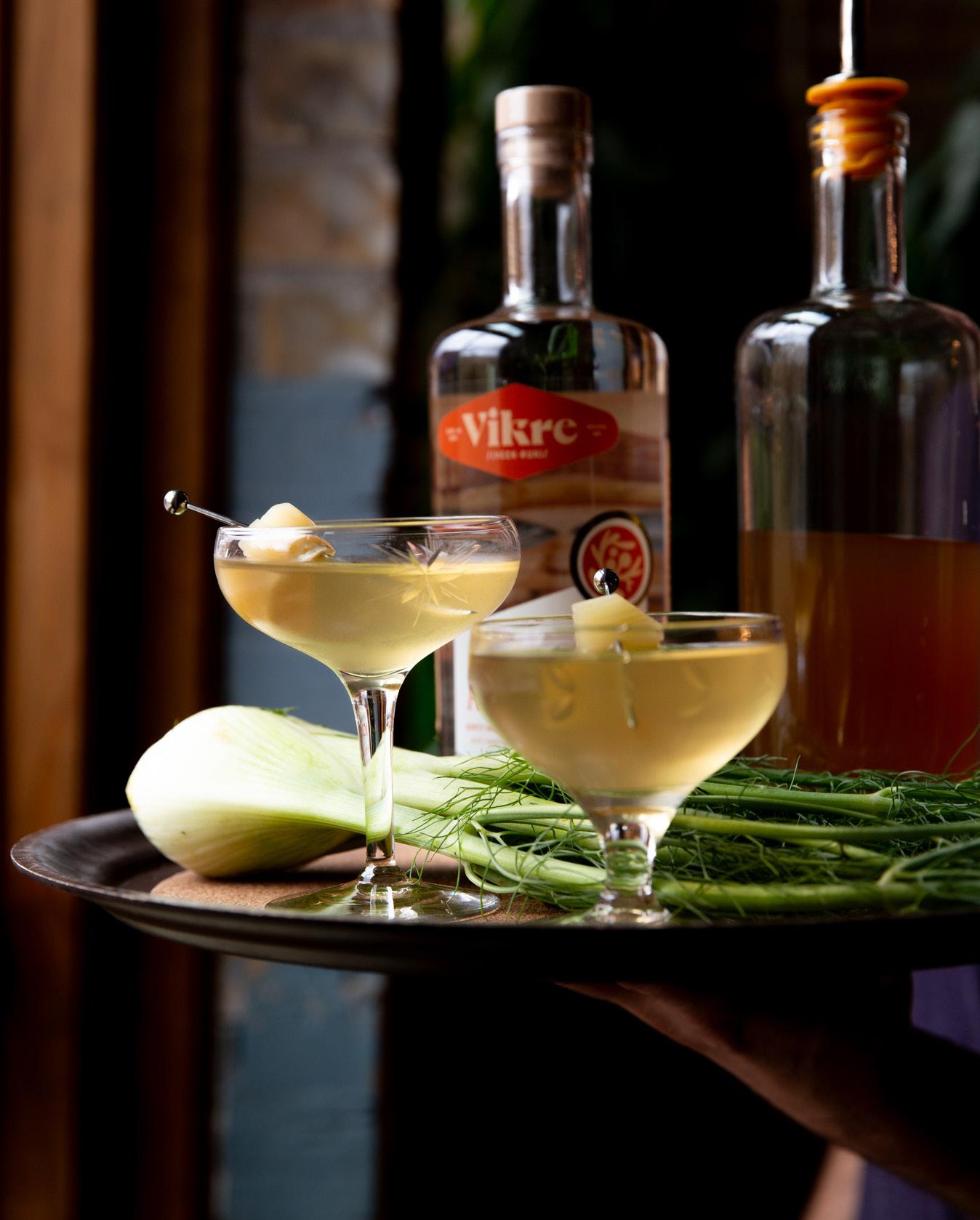

possible to get from wheat or potato vodka. He adds a bit more botanicals than are typical for aquavit, contributing spice to the dill, caraway, and anise with clove, coriander, and cardamom pods, and brightness with lemon peel and orange peel. NightSide ages the aquavit in American oak bourbon barrel casks for as long as the spirit needs, pulling it on taste. “It rests and mellows in the barrels, and picks up some bourbon characteristics, which gives it some American flavor,” Greene says.
A distillery devoted entirely to aquavit, Norden has the most room to play with the


varying nuances that can come from different barrels and different lengths of aging in them. Cleveland abides by European standards, then adding some level of innovation (excluding his traditional Original Taffel Style Aquavit), and as many local ingredients as possible to ground this Scandinavian spirit in Midwestern agriculture.
He crafts a Strawberry Rhubarb Aquavit, which also employs hibiscus and damask rose, and recently added a Jule Aquavit to his lineup. It’s aged for 13 months in a rye whiskey cask, and then 18 additional months in a

porter beer barrel from Ann Arbor’s Mothfire Brewing—at the one year mark, Cleveland added an infusion using his organic neutral spirit, molasses, dates, almonds, clove, nutmeg and ginger. Norden’s barrel-aged experiments began, though, with American Oak Reserve, his taffel-style aquavit aged for at least a year in American rye whiskey casks. This led to the Kuriosa Kollektion, Norden’s entire line of barrel-aged aquavits.
Kuriosa Kollektion Release #1 spends two years in Michigan apple wine casks that previously held Michigan rye whiskey. #2 spends four years in an American brandy cask, then six months on black walnut shells with almonds, cherry eau de vie, and cognac. #3 is aged for 18 months in a Kentucky bourbon barrel, then six months in a bourbonaged stout barrel from Ann Arbor’s Homes Brewery; #4 ramps the bourbon barrel time up to two years and the beer barrel to one year, and both are proofed down with birch water, a nod to the Scandinavian tradition of birch in vodkas and liqueurs. #5 combines the taffel-style and strawberry rhubarb aquavits, aged in separate bourbon and rye whiskey barrels for 14 months, blended, and aged for 16 months more in sherry casks.
“We’re making something traditional, but in such a way that I don’t think anybody else in the United States is doing,” Cleveland says.
“In Scandinavia, as with many places, people look at something old and traditional and associate it with a thing that belonged to their grandparents, or as stale, or with bad decisions around the holidays,” Vikre says.
“In America, bartenders and distilleries don’t have those associations [with aquavit]. It’s unique and esoteric, and they’re using it in creative ways.” This, she adds, has even been inspiring bartenders in Scandinavia to begin experimenting with aquavit again.
While consumer education remains the biggest hurdle these distillers face in American aquavit’s early stages, they’re finding success through those eager bartenders and welltraveled imbibers, and by presenting aquavits on gin flights to give customers an accessible starting point. While Loeffelholz says he doesn’t see aquavit ever reaching the stratospheric heights of something like tequila or mezcal, there’s room for aquavit to grow and momentum in its progress so far, thanks to the way American distillers are preserving tradition while finding outlets for familiar and creative flavors. ■

“We’re making something traditional, but in such a way that I don’t think anybody else in the United States is doing.”
—Robyn Cleveland of Norden Aquavit
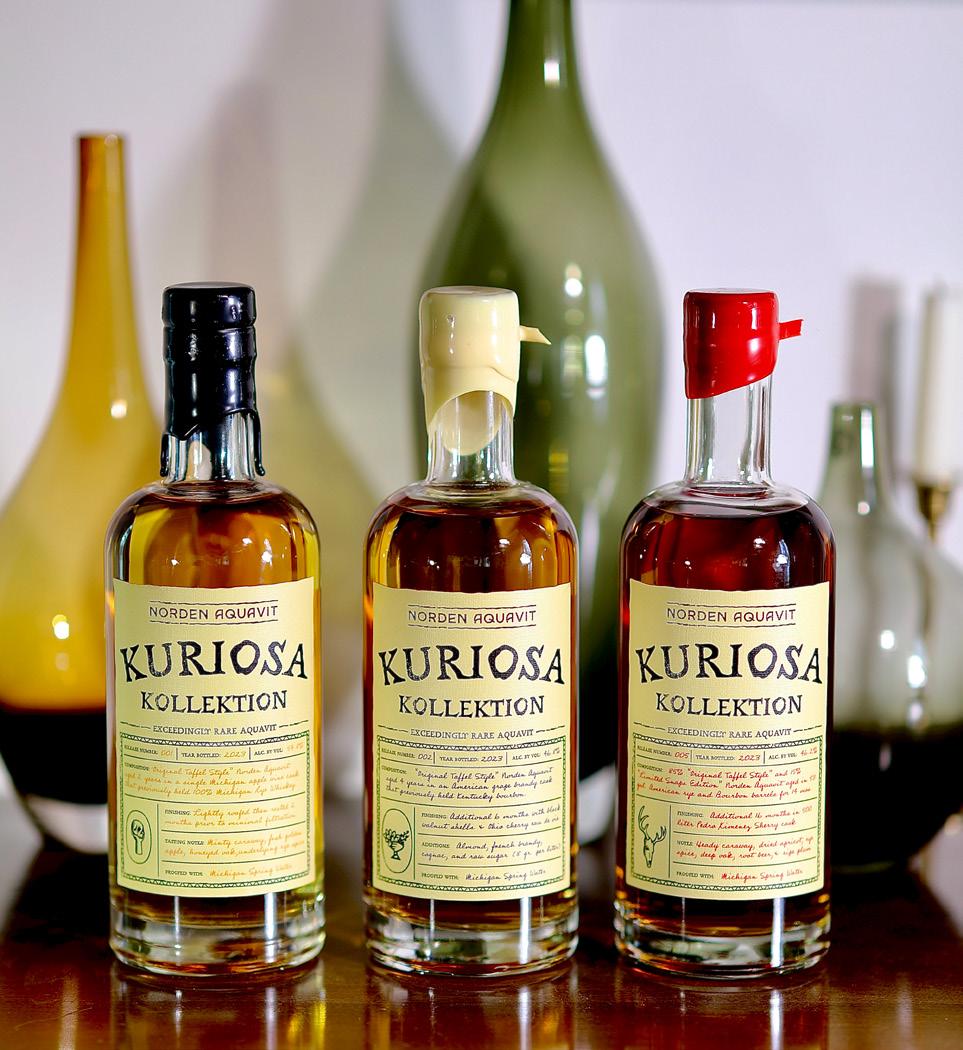


Getting to know ACSA member producers in their own words



Founded in 2015 and opened in 2016, Eight Oaks Farm Distillery in New Tripoli, Pennsylvania, is dedicated to crafting high-quality spirits rooted in regenerative agriculture and community values. Founded by Chad Butters, Carly Butters Snyder and Jesse Tyahla, the distillery brings purpose and passion to every bottle, celebrating Pennsylvania’s heritage and fostering meaningful connections.
Distilled Down: Our business was founded on the concept of an infinite cycle that begins with our purpose. At the heart of everything we do is our commitment to make a better place. It’s what guides our decision-making process. Our purpose renews the land, our land nurtures our farm, our farm inspires our spirits, our spirits gather our community, and our community supports our purpose. It is this infinite cycle that powers and sustains our business.
Vibe: Down to earth, authentic, welcoming. The distillery yard is filled with families, couples and friends who are focused on each other and connection. There are no TVs, people aren’t sucked into their phones. We have a crew who genuinely care about the customers and it creates a very homey atmosphere. Everyone is welcome!
Playlist: We listen to a lot of singer/songwriter, folk and 70s. If we are only running production and the tasting room is closed, we occasionally will throw on some fun 90s throwbacks or Sabrina Carpenter and Chappell Roan! We have a Spotify playlist called Whiskey and Rocking Chairs—listen with us!
Inspiration: There are too many distilleries and other businesses out there that inspire us to mention here. Instead, we would simply like to thank and honor every business out there who is committed to strengthening their community. This is hard work and we are encouraged to see other businesses around us putting in that work every day.
Flagship Spirit: Rye Whiskey! We are passionate about Rye Whiskey and its deep roots in Pennsylvania. We are growing all our own grains and we love the complex flavors it offers.
Additional Notable Spirits: Barrel Aged Applejack is one of our favorites. We use 100% local apple cider and no additives whatsoever. Our Veterans Cut Bottled-InBond Bourbon and Rye whiskeys are our pride and joy!
Buzzworthy: We launched our updated branding in October. This was a labor of love that took us two years to complete. Our friends at Makers & Allies worked diligently to bring what is authentically Eight Oaks to life in each detail. Every detail of our custom bottle was intentional. Every color and logo mark has meaning and we are so proud of how it turned out.
In the Near Future: We just released an Espresso Martini RTD that is so tasty. We will release Cask Strength Bourbon and Rye this year and we are so excited for everyone to try them. We have a lot of fun things in the pipeline for 2025!
The Distant Future: Ten years from now, we hope Eight Oaks will be a household name in our region for authentic and delicious spirits and especially for our commitment to community and regenerative agriculture. We will continue to welcome customers to the farm to unplug and connect with friends and family, and hope those enjoying Eight Oaks at home will do the same!
Advice for Anyone Thinking About Starting a Distillery: Find your purpose before starting any endeavor. Make sure that whatever you choose to do, it is in line with that purpose.
Learn more at eightoaksdistillery.com
Founded in 2012 by father-and-son team Dave and David Woods, Wiggly Bridge Distillery in York, Maine, embodies the spirit of craftsmanship and community. From its self-designed and built copper pot stills to its commitment to quality and authenticity, this family-run distillery has earned a reputation for exceptional small-batch spirits and a warm, welcoming atmosphere rooted in their historic 1800s barn.
Distilled Down: We take immense pride in our handcrafted, small-batch approach to distilling. The most important thing we want people to know is our dedication to quality and sharing our passion with our customers and community. Every drop of our spirits is meticulously crafted using copper pot stills that we designed and built ourselves. This hands-on process ensures each batch is unique and of the highest quality. Additionally, our family-run business is deeply rooted in the local community, with a commitment to build a legacy not only for our family but also for our community. We’re passionate about creating exceptional spirits that reflect the character of York, Maine.
Vibe: You step in an old 1800s barn in which the character of the barn has been preserved while integrating distilling technology. The vibe at Wiggly Bridge Distillery is warm, inviting and authentically artisanal. There are no TVs so you can be present and truly connect.
Playlist: Easy listening, coffee house, acoustic remixes
Flagship Spirit: Our Small Batch Bourbon and Bottled in Bond
Additional Notable Spirits: Agave, Rum and Vodka
Buzzworthy: After a long and hard-fought battle, we’re thrilled to share that we successfully stood up for small craft distilleries like ours. Facing opposition from a few neighbors who tried to equate us to mega-distilleries and claimed any expansion would harm the town, we worked tirelessly to prove otherwise and defeated a citizen initiative put forth on our local ballot to restrict our distillery’s
operations to the point of not being able to adapt or grow despite being in an industrial zone. We even had a blind DNA analysis done by a renowned mycologist to address concerns and highlight the truth about our operations. This victory not only affirms our dedication to quality and responsibility but also sets a precedent for supporting small businesses in the community.
In the Near Future: We’re excited to announce that we’ll be adding a kitchen to our distillery! This new addition will allow us to pair delicious, thoughtfully crafted food with our spirits, creating a full sensory experience for our guests. It’s a new chapter for Wiggly Bridge Distillery, and we are hoping in 2025 we can get back to what we enjoy most—producing high quality small batch spirits.
The Distant Future: In 10 years, we hope Wiggly Bridge Distillery has continued to grow into a renowned destination, known for its exceptional spirits and vibrant community presence. The distillery would have expanded facilities to incorporate a kitchen and more

room for storage and ease of production, while still retaining its handcrafted, small-batch essence. Our tasting room is bustling with guests enjoying guided tours, tastings and immersive experiences in distilling and cocktail making. Our beautiful 1800s barn hosts events and dinners, creating a lively and welcoming atmosphere. Our partnerships with local farmers and grain producers are flourishing. The Wiggly Bridge brand continues to be recognized nationally, our spirits continue to win prestigious awards, and our family legacy continues to thrive, inspiring the next generation of distillers.
Advice for Anyone Thinking About Starting a Distillery: Starting a distillery is an incredible journey, but it’s not for the faint of heart. It takes passion, dedication, patience and a true commitment to your craft. It’s certainly not a get-rich-quick venture—there’s a lot of research, planning and forecasting involved. If you want to be a true craft distillery, it’s all about focusing on quality over quantity, investing in the best ingredients and equipment, and staying true to your values. Your reputation will always hinge on the quality of your product if you want people to keep coming back.
You need to be passionate and dedicated enough to problem solve whatever comes your way. We never imagined we’d face the possibility of having to close our doors because a few neighbors latched onto sensationalized claims happening in another part of the country. It tested us in ways we couldn’t have anticipated. But our passion and determination carried us through those tough times, and looking back, we’re reminded of why we started this journey in the first place.
Learn more at wigglybridgedistillery.com.
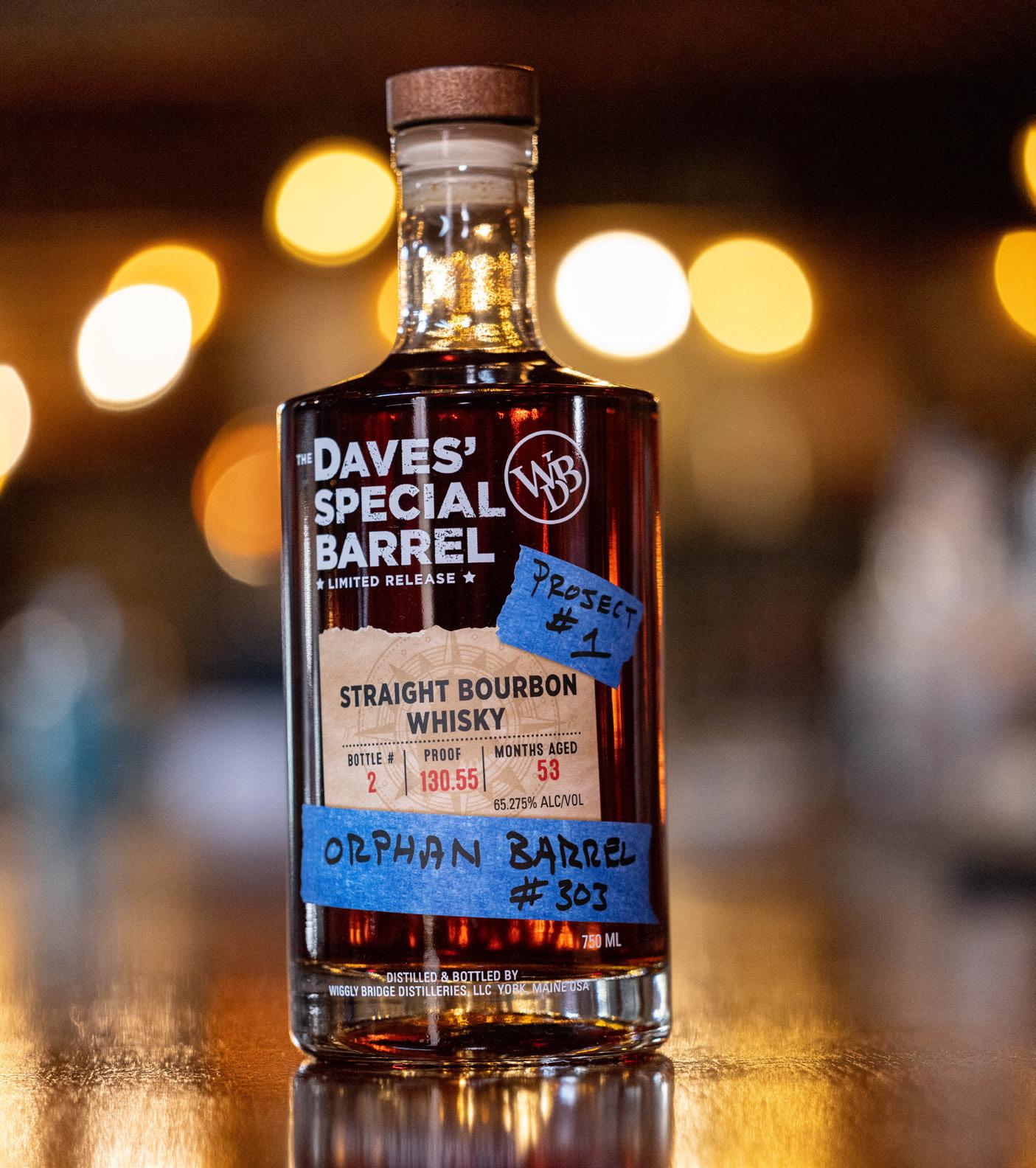



Established in 2013 in Astoria, Oregon, by Larry and Christina Cary, Pilot House Distilling began crafting “The Spirits of the Coast.” In 2020, the distillery joined forces with nearby Buoy Beer Co. and continues to grow its presence as a pillar of the Pacific Northwest’s craft beverage scene.
Distilled Down: The most important thing about our distillery is our unwavering commitment to craftsmanship and innovation. Every spirit we create is rooted in quality, using thoughtfully sourced ingredients and time-honored techniques, yet always with a bold, creative twist. From our award-winning Painted Lady Gin to our ocean-aged A-O Come Hell or High Water Whisky, we strive to push boundaries while staying true to authentic distilling traditions. Above all, we want people to know that every bottle represents not just a drink, but a story—of passion, place, and purpose. Whether you’re enjoying a cocktail in our tasting room or discovering our spirits for the first time, we aim to offer an experience that’s memorable, meaningful, and distinctively ours
Vibe: Eclectic and unique
Inspiration: We draw inspiration from our coastal community, where hardworking fishermen, artisans and entrepreneurs continually redefine what’s possible. Nature itself is a powerful muse, with the rugged Oregon coast and its untamed beauty influencing both our ingredients and our process. We’re also inspired by those in the distilling world who came before us, blending time-honored traditions with modern creativity. Ultimately, we’re driven by the people who enjoy our spirits—those who

appreciate craftsmanship, authenticity and bold flavors. They inspire us to keep experimenting, keep innovating, and keep striving to make something truly exceptional.
Flagship Spirit: Painted Lady Gin. This award-winning gin, including recognition as Best of the Year, has earned numerous accolades. It’s a distinctive New American-style gin, crafted with a blend of unique herbs that set it apart.
Additional Notable Spirits: One standout is the Astoria Mary, Oregon’s first-ever canned cocktail. Another is A-O Come Hell or High Water Whisky, a unique spirit that’s oceanaged aboard local fishing vessels, adding a distinct maritime character.
Buzzworthy: We are moving our Astoria tasting room right across the street at 1343 Duane St. from 1270 Duane St. We are moving as we speak. We have moved our production facility locally as well. We are also coming up on our 12th anniversary on Feb. 14. We are also going to have a space at the Portland Airport in early 2025.
In the Near Future: We will be doing a special release of A-O Come Hell or High Water for our anniversary. Batch #16 fished on the famous F/V, the Maverick. Known from “Deadliest Catch.”
The Distant Future: In 10 years, our distillery is a thriving, well-recognized brand that’s become a cornerstone of both the local and broader spirits community. Our facilities have grown to accommodate increased production, with cutting-edge equipment seamlessly blending
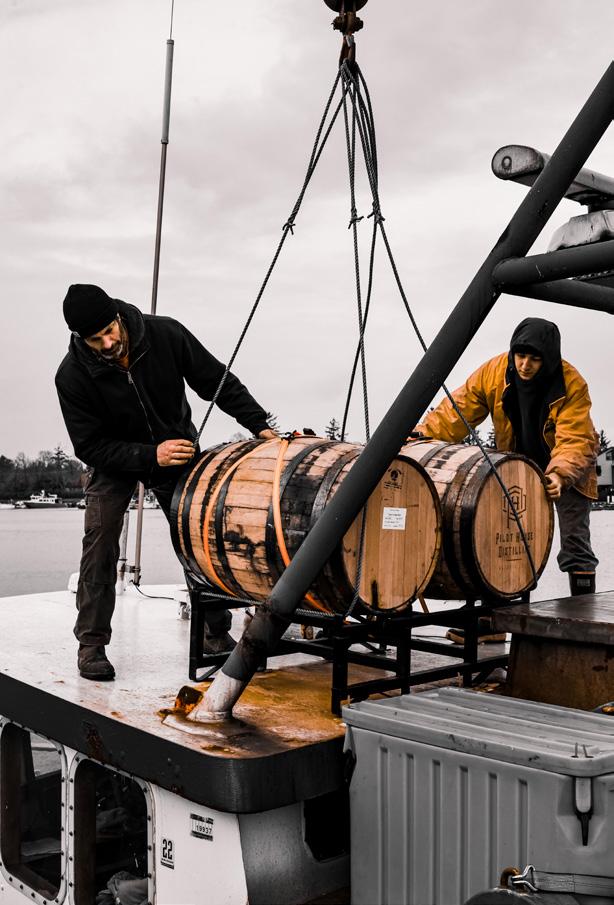
traditional craftsmanship with modern innovation. A larger aging room holds barrels of premium whiskies and experimental batches, while our expanded botanical garden supplies fresh, unique ingredients for our signature gins. Visitors from around the world come for immersive tours and tastings, learning about our distinctive process and the stories behind each of our spirits. Our tasting room and cocktail bar are bustling hubs of activity, offering exclusive, limited-edition releases alongside expertly crafted cocktails. Regular events—like distilling workshops, community festivals, and collaboration launches—keep us engaged with our loyal following and attract new enthusiasts. Looking ahead, our distillery is not just a place where spirits are made—it’s an experience, a destination, and a community. We’ve built something that lasts, something we’re proud of, and something people will continue to enjoy for generations.
Advice for Anyone Thinking About Starting a Distillery: Navigate regulations early, the legal side is extremely complex. Quality over quantity always wins so MASTER YOUR CRAFT! Know your market. Research your target audience and understand what they want. Are they drawn to traditional spirits or more innovative, experimental flavors? Tailor your offerings accordingly. Plan your finances carefully: Distilling is capital-intensive, especially with the long lead times for aged spirits. Make sure you have a solid financial plan and enough runway to support your operations through the early stages. Lastly, buckle up for the long haul. It’s going to be hard, but distilling is a marathon, not a sprint.
Learn more at pilothousedistilling.com.



Arizona’s distillers embrace their rugged environment to create spirits that reflect the state’s diverse landscapes and culture.
BY JOHN HOLL
What’s the best way to describe the craft distilling scene in Arizona? It matches the climate, says Deborah Patt, the founder and owner of Desert Diamond Distillery in Kingman, near the California and Nevada borders.
“It depends on the elevation,” she says.
Adventurous Stills in Tempe and OHSO Brewery + Distillery in Phoenix are just over 1,000 feet above sea level; Whiskey Del Bac in Tucson is at 2,400 feet; Patt’s Desert Diamond Distillery is high desert at 3,300 feet, and several Flagstaff distilleries are at 7,000 feet.
“All of us are exceedingly dry with low single-digit humidity for the lows throughout much of the year and we’ve all had to adjust to extreme climate conditions to distill and age whiskey, and in our case, to malt,” says Stephen Paul, who co-founded Whiskey Del Bac with his daughter, Amanda Paul. “So, while there are others in the country who have had similar challenges, it’s no small testament to the grit and determination Arizona distillers have across the board.”
The best of the state will be on display this March as the American Craft Spirits Association hosts its annual convention and expo in Tucson.
“Tucson itself has an incredible sense of community, combined with an intense culture of creativity, and layered with a rich blend of ethnic cultures that informs how we live here,” says Paul. “We celebrate our regionality through our flavor profiles and having branded ourselves after Mission San Xavier del Bac, our exquisite Spanish mission founded in 1694.”
In 2006 Paul and his wife Elaine had the idea to dry malt over a mesquite fire instead of a peat fire, for an American single malt whiskey that is truly from the Sonoran Desert.
Because of its geography, Arizona is at the forefront of many of the national conversations that are impacting the industry. Mark Beres, the CEO and president of Flying Leap Vineyards and Distillery in Elgin, is keen to talk about water.
He says that because of the climate and the unique challenges the state offers distillers, many have adopted innovative and highly efficient water management practices to remain viable. He notes that many distilleries invest in closed-loop cooling systems, which recycle water used during production to minimize waste. Others rely on renewable energy sources, such as solar power, to reduce their overall environmental impact while managing water resources judiciously.


“Some distilleries have embraced alternative base materials that require less irrigation or can be sourced from local suppliers who already operate with sustainable practices,” says Beres. “These adaptations not only help conserve water but also contribute to the unique identity of Arizona-crafted spirits.”
Talk to the craft distillers in Arizona and they revel in an identity that offers up a bit of the unexpected when it comes to their spirits. John Patt of Desert Diamond Distillery delights in showing off his rum “from a place no one expects.”
Place is well entwined in all the products Dr. Garrison Ellam of Arizona Craft Beverage in Elgin distills. The company’s brandy, gin and vodka come from Arizona-grown wine grapes. The whiskeys are made from grains grown in the southern part of the state. His rums are made from Arizona and Sonoran cane while the molasses used comes from just across the border in Northern Mexico.
All glass is Mexican production from high cullet content, he says. “Boxes are made in Tucson. Labels are made in house from paper and inks made in the USA. We use non-treated water. We supplement our energy from wind and solar, we direct fire with propane and carbon scrub fermentation gases. All [pomace] and wort remains are fed to local cattle and hogs. End of life barrels are recycled into furniture and artwork, including the hoops and nails, which are given to local artisans and blacksmiths.”
Additionally Desert Diamond and Arizona Craft have a joint production Rum and Rye, using a colonial era recipe for the beverage.
Beres says the company’s wine side has helped establish a quality reputation for its spirits and to entwine both.
“As vintners, we understand the value of
“Tucson itself has an incredible sense of community, combined with an intense culture of creativity, and layered with a rich blend of ethnic cultures that informs how we live here.”
—Stephen Paul of Whisky Del Bac







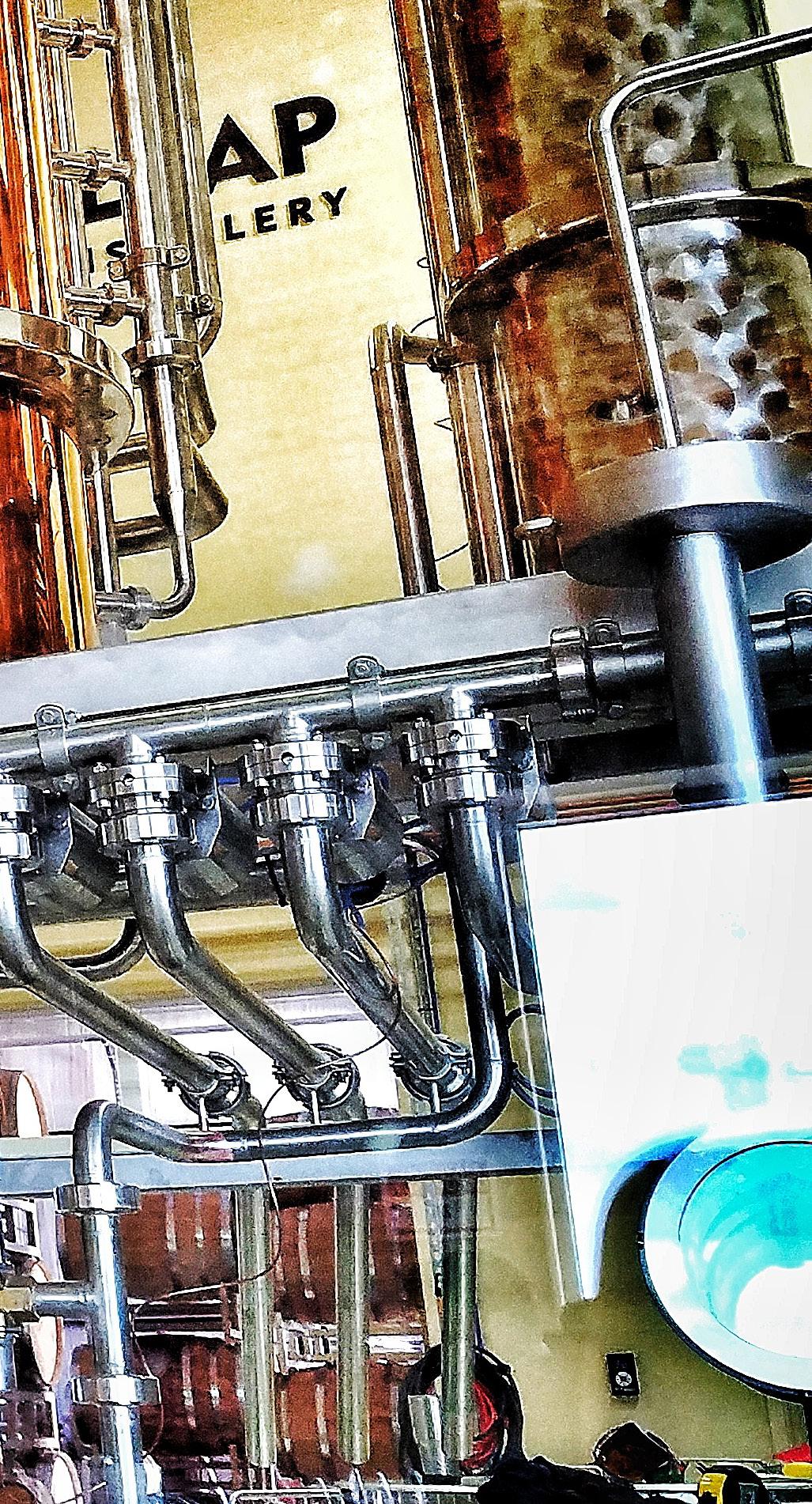

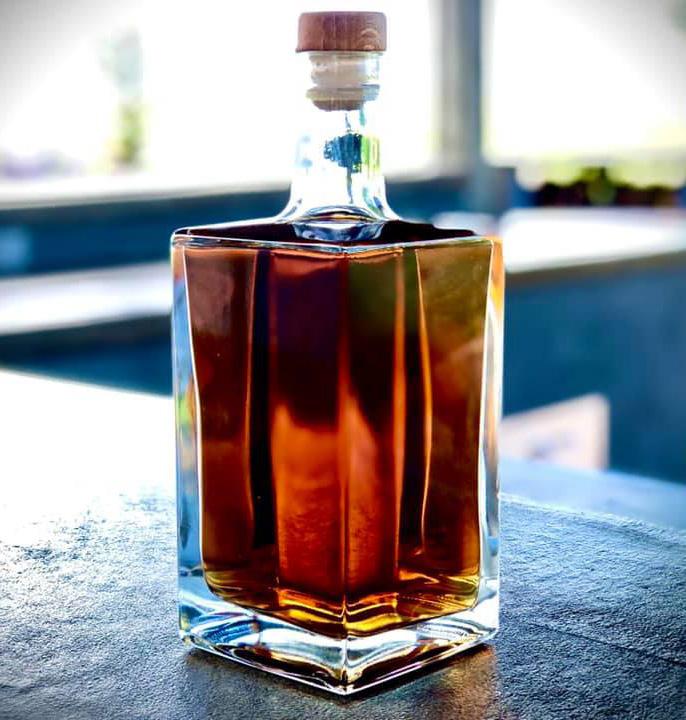

Because of its geography, Arizona is at the forefront of many of the national conversations that are impacting the industry.
patience, allowing our spirits to mature gracefully over time,” he says. “We are particularly proud of our grappa production, which utilizes the pomace from our winery’s operations to create a distinctive, hand-crafted spirit that highlights the essence of our Arizona-grown grapes.”
There’s a balance in catering to a large tourism industry and the locals. It can be a challenge, but one many are rising to meet. In some cases, it means reinventing recipes or changing the way venues are set up. In other cases, it’s about being a community hub.
“As far as tourism and locals, those are two very different demographics, but both are needed for every distillery to really continue their growth and to build trust and knowledge out to and in the community,” says Deborah Patt. “Some communities are more accepting and open than others.”
In the state, craft distillers are limited to producing no more than 20,000 gallons of distilled spirits annually, notes Beres. “The restriction is designed to maintain the artisanal nature of craft distilleries, encouraging small-scale, highquality production while distinguishing them from larger commercial operations.”
Despite this limit, Beres says the license provides flexibility, allowing distillers to sell their products directly to consumers, distribute to wholesalers, and operate tasting rooms, fostering a closer connection between distillers and their customers. The state also allows craft distillers to self-distribute their products.
For even those passing through, it’s hard not to be taken with the beauty of Arizona, and a deeper look into the distilleries that dot the state gives an inspiring look at the craftsmanship that goes into giving the spirits a sense of place.
“Honestly, we are very proud of the fact that we make 100% of our spirits, and we have succeeded for more than 15 years in a very difficult industry,” says John Patt. “We are proud of our distillery friends who have made it this long. I always say I got in this business to age. I have not done so well but our barrels have.” ■

This elevated take on the Full Monte cocktail comes from Botanery Barn Distilling in Elverson, Pennsylvania. Featuring Revivalist Garden Gin, it’s a sophisticated blend of botanicals, citrus, and bittersweet notes that’s sure to delight.
Ingredients
1 1/4 ounces Revivalist Garden Gin
3/4 ounce Triple sec
3/4 ounce Aperol
3/4 ounce Dry vermouth
Directions
Add all ingredients to a mixing glass filled 3/4 with ice. Stir for one minute. Double strain into a chilled Nick & Nora glass. Express and garnish with an orange peel.
This cocktail from Elverson, Pennsylvania-based Botanery Barn Distilling puts a botanical twist on a classic sour. With Revivalist Garden Gin and a touch of elderflower syrup, it just might win over even the most loyal Whiskey Sour enthusiasts.
Ingredients
2 ounces Revivalist Garden Gin
1 ounce lemon juice
3/4 ounce elderflower syrup
Pinch of celery salt
Directions
Add all ingredients to a shaker and shake without ice. Add ice to the shaker and hard shake. Strain into a rocks or coupe glass and garnish with an ornamental flower.


Bright, bold and perfectly balanced, the Raspberry Habanero Lemon Drop from Quartz Mountain Distillers in Vancouver, Washington, is a vibrant cocktail crafted with the distillery’s Raspberry Habanero Vodka. The natural sweetness of ripe raspberries and the fiery kick of habanero harmonize beautifully with fresh lemon juice and a touch of lemon-lime soda for a zesty, sweet-heat experience.
Ingredients
1/4 cup fresh raspberries plus more for garnish
3-4 ounces Quartz Mountain Distillers Raspberry Habanero Vodka
4 tablespoons fresh lemon juice plus lemon slices for garnish
1/4 cup lemon lime soda
4 tablespoons sugar
Directions
Muddle raspberries with sugar. Press through a wire mesh strainer to remove seeds. Press the berries down to release as much juice as possible. Mix raspberry puree, vodka, soda, lemon juice and ice in a cocktail shaker. Shake to combine and pour and serve. Garnish with lemons and raspberries if desired.
The Mountain Mary is a bold Appalachian twist on the classic Bloody Mary from Swilled Dog in Upper Tract, West Virginia. Crafted with Swilled Dog Straight Bourbon Whiskey and West Virginia Harvest’s Mountain Mary Ramp Bloody Mary Mix, this cocktail celebrates the earthy, rich flavors of West Virginia. With its ramp-infused base and hearty garnishes, it’s the perfect blend of tradition and adventure.
Ingredients
2 ounces Swilled Dog Straight Bourbon Whiskey
5 ounces West Virginia Harvest Mountain Mary Ramp Bloody Mary Mix (or your preferred bloody mary mix)
1 teaspoon prepared horseradish (optional, for a spicy kick)
Directions
1. Fill a glass with ice, pour in all ingredients and give the mixture a gentle stir. Garnish with a celery stalk, pickles, olives and cheese cubes. Optionally, add a dash of your favorite hot sauce or ground black pepper to customize the flavor further.


This cocktail from Quartz Mountain Distillers in Vancouver, Washington, showcases the rich complexity of the distillery’s Maple Syrup Cask Whiskey. This vibrant cocktail combines the whiskey’s toasty maple sweetness with muddled fresh orange and lemon for a refreshing balance of bright and warm flavors. Finished with a touch of real maple syrup and seltzer it’s a seasonal indulgence perfect for sipping by the fire.
Ingredients
2 ounces Quartz Mountain Distillers—Maple Syrup
Cask Whiskey
1 1/2 ounces chilled seltzer
1/2 ounce fresh orange juice
1/4 ounce pure maple syrup, preferably Grade A dark amber
1/4 ounce fresh lemon juice
4 dashes of Angostura bitters
Half of an orange wheel
Directions
In a rocks glass, combine the maple syrup with the orange juice, lemon juice and bitters. Add the orange wheel and lightly muddle. Add the whiskey and stir well. Fill the glass with ice and top with the chilled seltzer.

This cocktail from Swilled Dog in Upper Tract, West Virginia, is a rich, golden drink that balances the smooth warmth of Swilled Dog Straight Bourbon Whiskey with the natural sweetness of honey and the bright zest of fresh lemon juice. Inspired by the beauty of the Mountain State’s golden sunsets and its spirit of adventure, this cocktail is a timeless yet approachable sip for any occasion.
Ingredients
2 ounces Swilled Dog Straight Bourbon Whiskey
3/4 ounce honey syrup (mix equal parts honey and warm water)
3/4 ounce fresh lemon juice
Directions
Add all ingredients to a cocktail shaker filled with ice and shake well until chilled. Strain the mixture into a rocks glass over a large ice cube and garnish with a lemon peel.
In this edition, we’re showcasing a pair of international gin destinations.

Prague, Czechia
The Tip: If you want to drink something other than gin, you’re out of luck.
The bartender at Frame made it perfectly clear to a handful of clueless tourists what kind of establishment they had just randomly stumbled into: “We only serve gin.” That fact is clear enough to anyone who glances at the bar shelves populated by upwards of 300 different bottles of botanical spirit bottles from around the world. And to call this a gin pub wouldn’t be entirely accurate. It’s proudly a Gin & Tonic bar, featuring 40-something different tonic selections to correspond with virtually every flavor profile of the spirits on hand. The décor is quite minimalist: black walls with the namesake (empty) backlit picture frames scattered throughout. The only non-blank frames in the entire place are the ones above the bar that hold blackboards with chalk-drink illustrations of G&Ts and a collection of descriptors that detail the range of flavor profiles available: sweet, bitter, fruity, herbal, spiced and fresh. There’s likely no better microcosm for the global gin renaissance than Frame.


Mr. Fogg’s Gin Parlour
London
The Tip: You’re going to need a reservation.
Let’s get this out of the way first: yes, it’s in London’s tourist-magnet Covent Garden district. But despite its location and its 19th-century, globetrotting theme that borders on kitschy (the fictional “Mr. Fogg” in question is Phileas, of “Around the World in 80 Days” fame), the speakeasy-esque space upstairs—via hidden entrance, away from the much more raucous, standing-room-mostly Mr. Fogg’s Tavern—is much more education-forward, connoisseur friendly and serious about its spirits and cocktails than it really needs to be in its neighborhood. It truly is a parlor, with upholstered antique chairs as the main seating options, friendly, knowledgeable staff and some astoundingly innovative cocktails named after international cities (Paris, Venice, Calcutta and Singapore, to name a few) that highlight gin’s versatility. If you want a gin and tonic, you’ll have to use the QR code to see the full list—somewhere in the neighborhood of 150 gins, accompanied by a formidable number of tonics of varying flavor profiles. The G&Ts themselves are nothing short of theater, served in the now-standard goblet, with fresh garnishes that range from sweet to savory to bitter to herbal and some of the clearest, most carefully carved giant cubes of ice that would make even the most professional sculptors jealous.
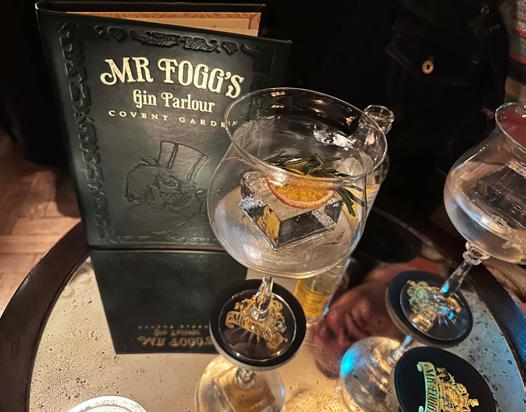
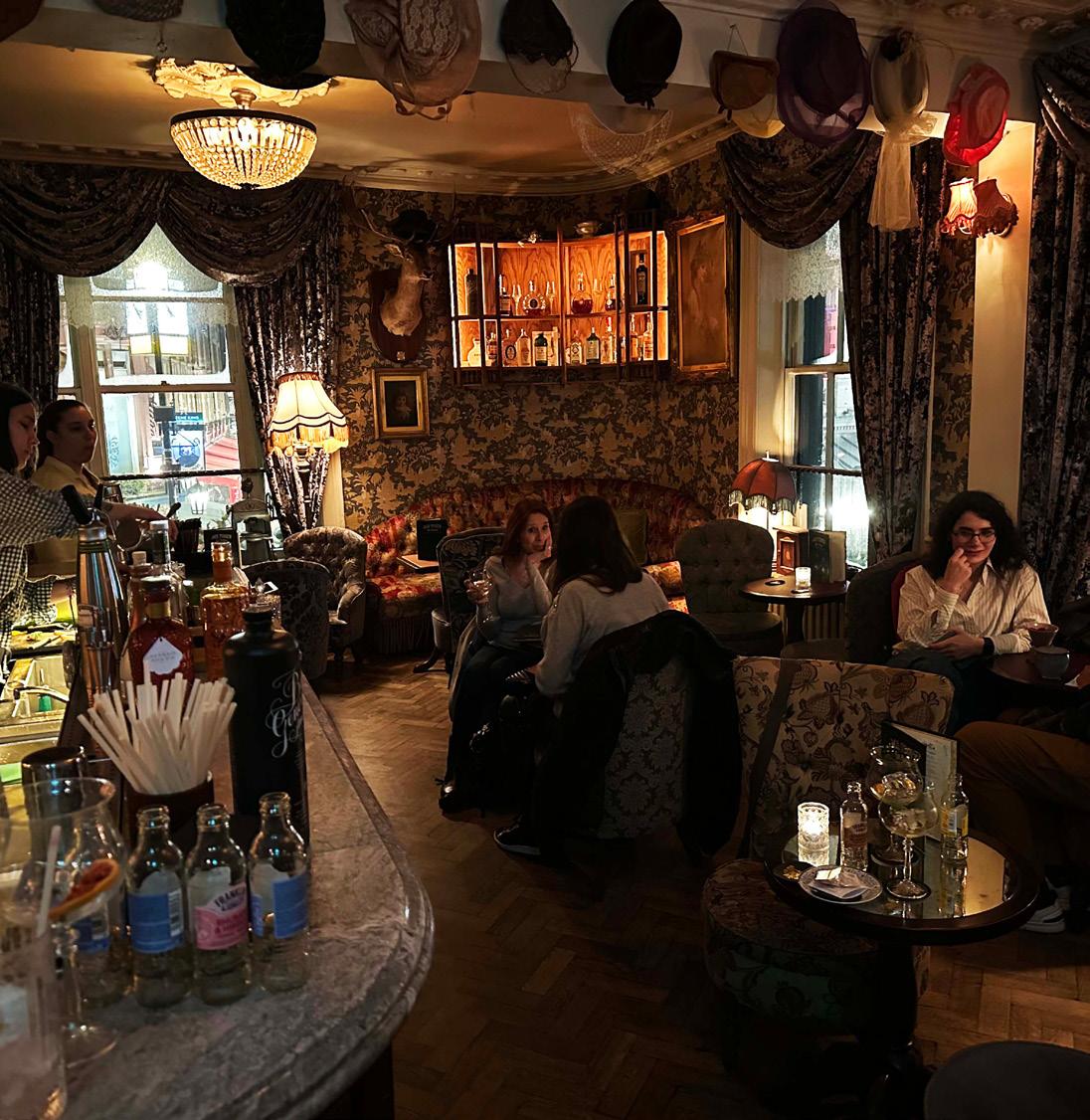



BY DEVON TREVATHAN
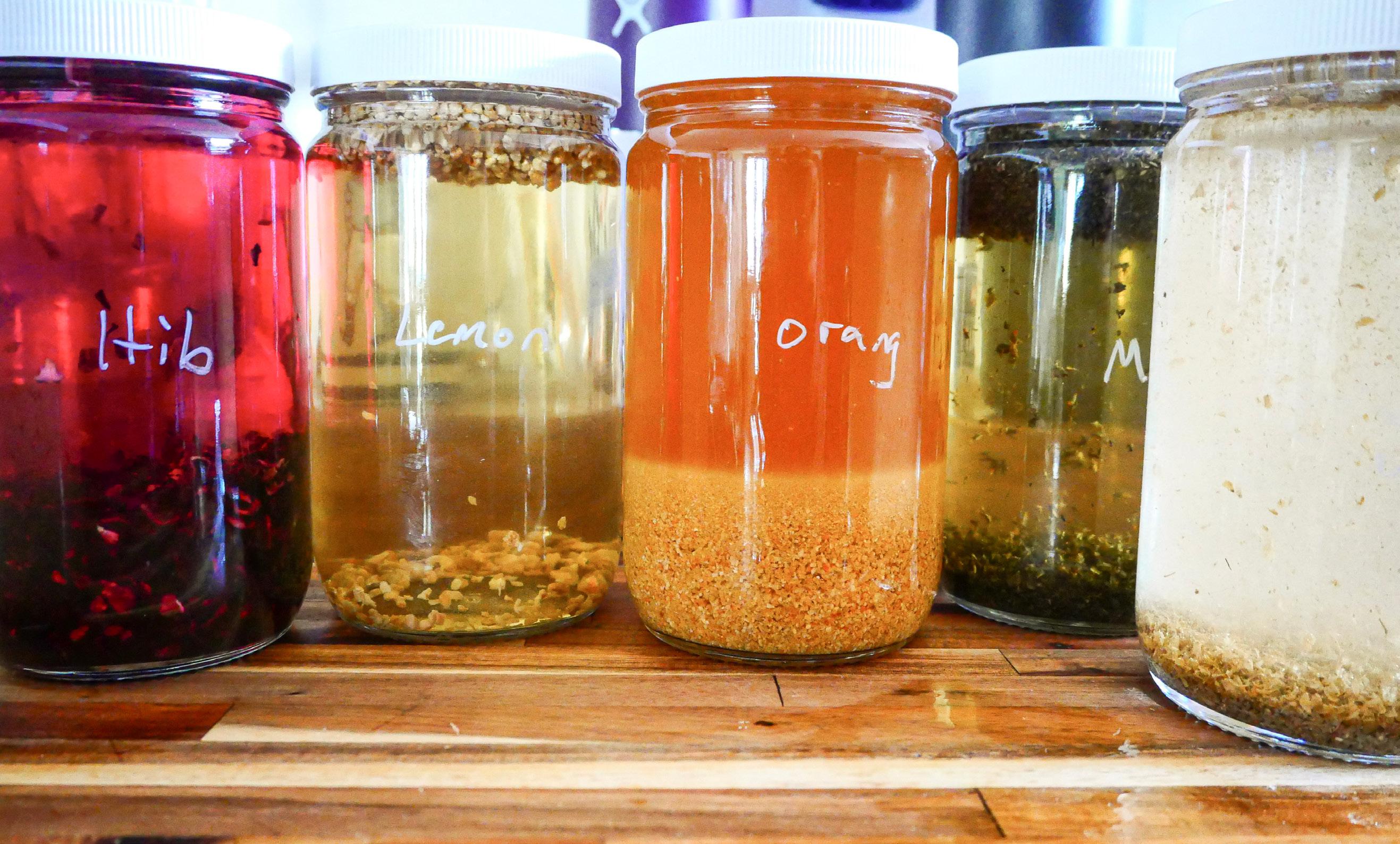
Back in the mid-aughts, a South Tyrolean take on the Aperol Spritz called the Hugo Spritz became wildly popular along the Italian-Austrian border, replacing the red aperitivo with sciroppo di sambuco, or elderflower syrup. When it was adopted in America, this translated to a spritz made with the French elderflower liqueur St. Germain, since the white flower isn’t as common here. In 2023, the cocktail took over DrinkTok and was dubbed the “drink of the summer,” to the confusion of many. The Hugo Spritz didn’t satisfy the previously assumed requirements for a viral cocktail: It had no strong color, it wasn’t particularly punchy, and it was without a very memorable flavor. But that, perhaps, was its core strength—it was approachable. There is no barrier to entry with the Hugo Spritz. It’s as enjoyable to a masochistic amari drinker as it is to a suburbanite who loves their white wine coolers.
Renewed interest has shone a light on bracing red aperitivi and punishing amari, but this world of beverages is not a flavor monolith, and many are appreciated for their lighter, more delicate notes. While you can certainly find more bitter examples of vermouth—which is defined by the inclusion of the bittering agent wormwood—many are lighter in overall character. Aperitivo, itself a subtype of amaro,
can go either way, with notable examples being highly bitter, in the case of Campari, and not very bitter at all, like Select Aperitivo. Many of the same ingredients are used in the production of these liqueurs—orange peel, quinine, rhubarb root. It then becomes a matter of balancing those bittering ingredients with secondary and tertiary flavors.
When bitter takes a back seat, elements like citrus, baking spice and stewed fruit can come to the forefront, and that can give you an in with bartenders as a producer. “First thing to consider with things like that is volume and viscosity, because a lot of those can be remarkably full bodied,” said Jordan Spaulding, beverage manager at Folk in Nashville, Tennessee. “How is that going to affect the mouthfeel of my cocktail?”
Wine-based aperitifs are usually lighter in body, as they sit lower on the alcohol content scale: typically between 16% and 22% ABV. Amari and digestivo can be higher in ABV, with certain examples, like fernet, rising over 40% ABV. Either way, more bitter flavor necessitates sweetness to offset it, so those products will have more sugar and thus a richer body.
Most aperitifs that don’t focus on bitter fall within the wine-based apero subcategories,
including vermouth, americano, quina and pineau des charentes, which are usually lighter in body as they sit lower on the alcohol content scale. There are the classics, almost all of which originated in Europe, among them Lillet, which first appeared in Bordeaux in 1872. Lillet starts with a Bordeaux wine base, which is then fortified with aromatized spirit, after which the mixture spends time in French oak. It’s not vermouth, though it is similar in texture and character. When it was known as “Kina Lillet”—kina being a reference to the quinine contained in it, which became less prominent following a reformulation in 1986— this aperitif was called out specifically by the fictional James Bond in the creation of a very real classic cocktail, the Vesper.
St Raphaël, a quina made in France dating back to 1830, also begins with a red wine base. The character of this aperitif, including both its rouge and ambre, is often described as rich, fruit-forward, and spicy, with notes of chocolate, orange peel, caramel, and vanilla. It is the dark equivalent contrasted against something like Lillet, but equally as useful.
It’s important to note that both lighter and darker aperitifs often still incorporate bitter flavors, they are just blended in so that they no longer dominate the overall palate. An

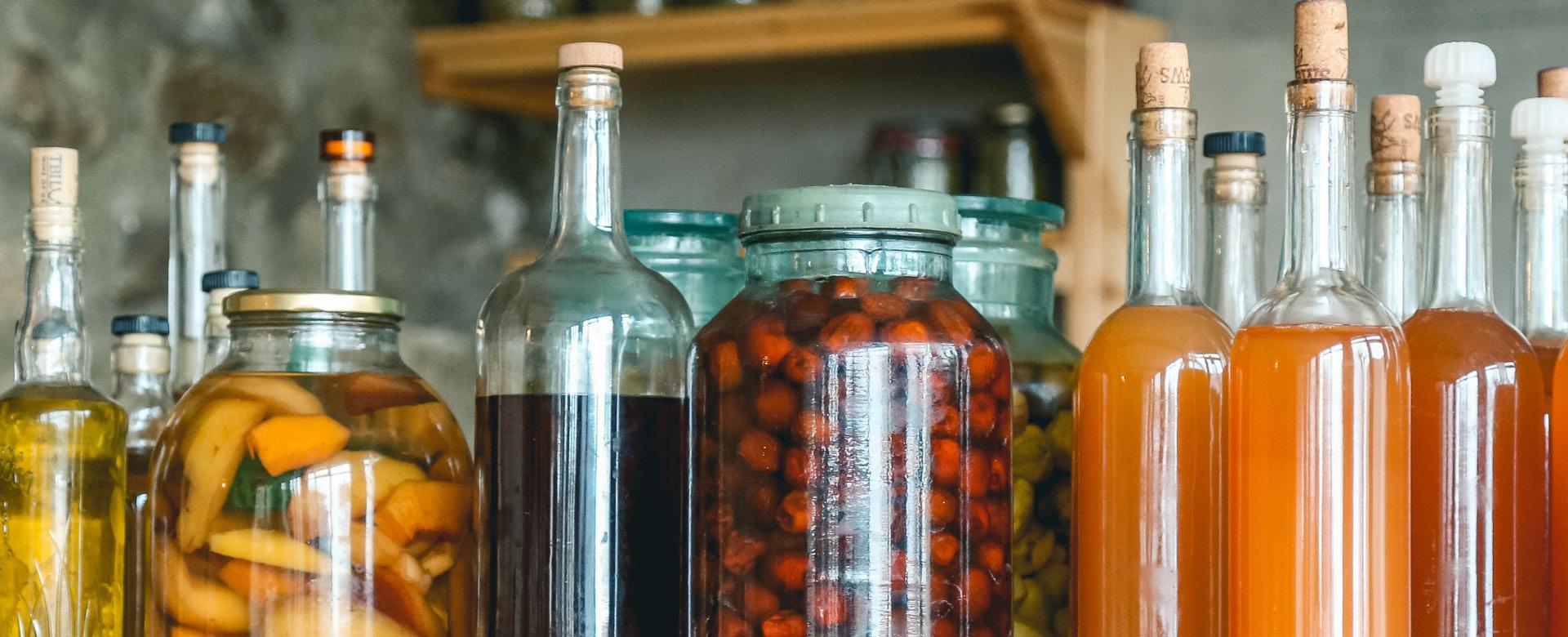
exception to that rule would be Pineau des Charentes, a regional aperitif from western France, which is not infused.
Pineau’s invention was supposedly an accident. Legend says that a winemaker in the 16th century accidentally added grape must to a barrel thought to be empty that actually contained eau de vie, and that the mixture was left in the cellar for quite some time. Years later, the resultant drink was discovered and quickly adopted. Now, Pineau is made by fortifying unfermented grape juice after pressing with young cognac brandy, and the mixture is aged in barrels for a minimum of 18 months. Though Pineau is made in both red and white styles, it’s not infused or flavored, and its character is considered on the sweeter side of aperitif, though the best examples balance the inherent acidity and aromatics from the must and the brandy.
Spirit-based apero liqueurs that eschew bitterness tend toward flavors that are either floral, citrusy, herbal, or baking spice-forward. The brand Italicus, launched in 2016, belongs to a category all its own: rosolio, which was
first produced by Florentine monks and nuns centuries ago. A version made with rose water, cloves, cardamom and cinnamon was favored by the court of Medici in the 16th century, and the Dukes of Savoy were said to be especially partial, serving rosolio at the royal court in Turin. As a category, rosoli are made by macerating flowers, herbs, fruits and spices, diluting it, and then sweetening the mixture with sugar beet syrup because the flavor was thought to be more pure than sugar cane syrup, allowing the delicate character of the rosolio to take center stage. Rosolio was never meant to be medicinal—it was, and remains, firmly a concoction taken for pleasure, which is reflected in its flavor.
Our bitter obsession can be a pill, but it’s not one we always need to swallow. Whatever a person’s palate, there is a style of infused liqueur to match it. As Spaulding explained, “they fit a niche that doesn’t need to be as one note as certain aperitivos can be or as fearfully aggressive as some digestivos can be.” Striking a balance never sounded so good. ■
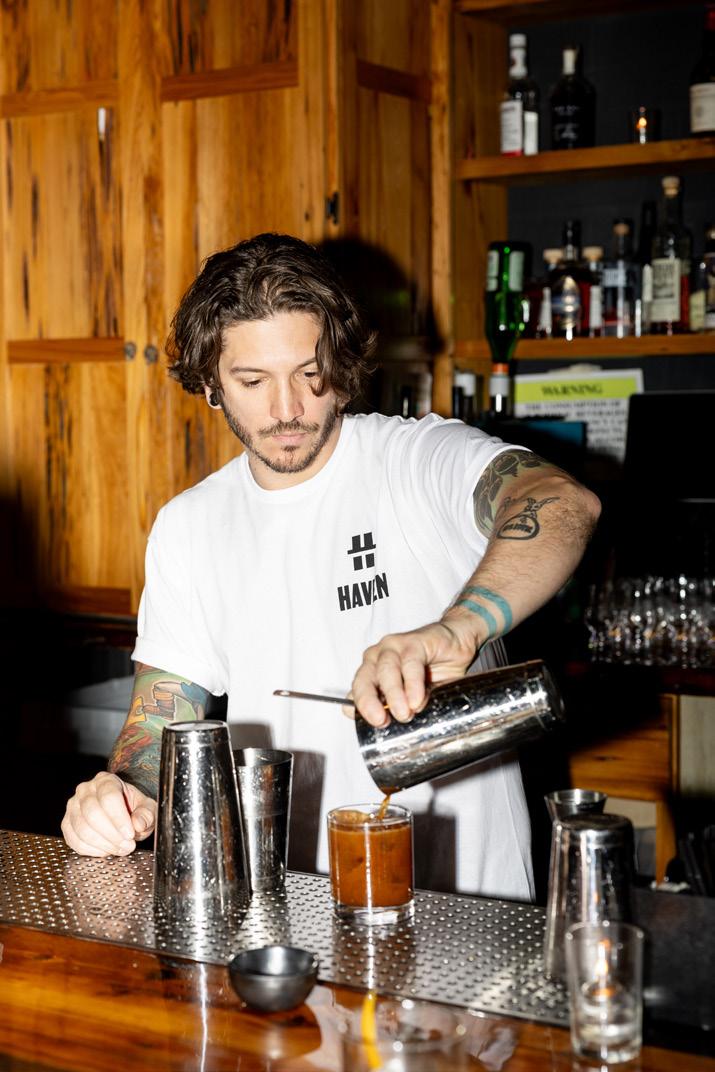
Jordan Spaulding
Our bitter obsession can be a pill, but it’s not one we always need to swallow. Whatever a person’s palate, there is a style of infused liqueur to match it.
Unaged corn whiskey showcases the distiller’s art and craft.
BY JEFF CIOLETTI

When it comes to unaged grain spirits, Colin Spoelman doesn’t mince words.
“For me, corn whiskey is the only white whiskey,” says the co-founder and distillery at Brooklyn, New York-based Kings County Distillery.
While producers of unaged rye and malt spirits might beg to differ, Spoelman is quick to point out that corn whiskey is the only new-make variety that the U.S. Alcohol and Tobacco Tax and Trade Bureau (TTB) officially defines. “It’s the only legally permissible category of unaged whiskey in the federal code,” he says.
For those who need a refresher, TTB’s definition states that corn whiskey must be made from a fermented mash that’s at least 80% corn, and, much like bourbon and, now, American single malt, be distilled to no more than 160 proof. But, unlike bourbon, it doesn’t have to be aged. If it is aged in oak barrels,
those barrels must be in uncharred or previously used ones.
“I grew up in eastern Kentucky, I grew up in a very moonshine-oriented part of America, when I learned to distill,” Spoelman notes. “Corn whiskey emerged in my mind as the artisan’s moonshine.”
And there’s no less artisanship involved in crafting an award-winning corn whiskey than there is in making a celebrated bourbon. For many, it’s an ideal way to spotlight the nuanced character of a grain that often can be taken for granted. “If we’re talking about showcasing raw materials, I would argue that the best way to show that is in an unaged product,” says Keener Shanton, head distiller at Old Forge Distillery in Pigeon Forge, Tennessee.
Old Forge is in the heart of the Great Smoky Mountains and benefits from the region’s storied moonshine history. “We get
a lot of people who come in who want to try something that they feel is rooted locally for the Appalachian region,” Shanton says. “A big part of our market is tourist-driven looking for maybe the novelty of 100-proof moonshine or an unaged product in a jar. There are some people who are interested in that raw, corn whiskey.”
The distillery uses locally grown corn, from Batey’s Farms in Murfreesboro, Tennessee, a family business that’s been operating for more than two centuries. But that’s not the only 19th-century connection. Old Forge has its own 1830s-built, water-powered grist mill that mills the corn for its spirits.
Old Forge’s Rocky Top corn whiskey’s mash bill consists of 83% yellow dent corn and 17% malted corn—which the distillery malts in-house. The malting isn’t for any diastatic purposes—“corn doesn’t do a great job of converting much more than itself,” Shanton
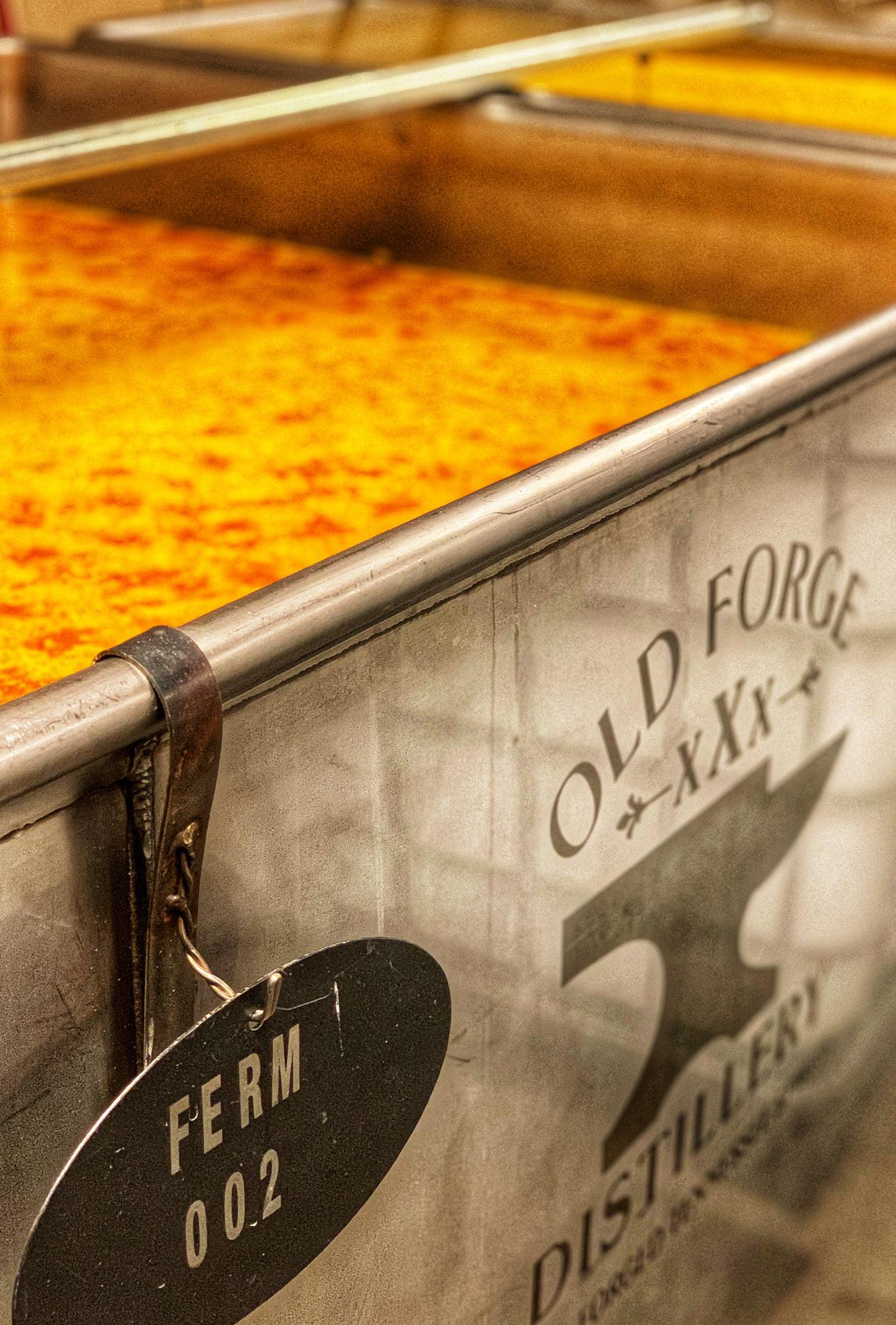


“If we’re talking about showcasing raw materials, I would argue that the best way to show that is in an unaged product.”
—Keener Shanton
of Old Forge Distillery

points out—it’s purely for flavor purposes. “Corn by itself can be boring,” Shanton contends. “It’s simply in there for character, for an earthy note, a little something to make our story a little richer.”
B.H. James Distillers in Adairville, Kentucky, also invests in local agriculture, procuring the raw materials for its Kentucky Grit corn whiskey from nearby Walnut Grove Farms. It’s one of only a handful of farms in the entire Bluegrass State that also grow rye and barley, which find their way into Kentucky Grit’s mash bill, as well—81% local, non-GMO yellow corn, 10% local rye, 5% crystal malt and 4% oats.
“The oats are pretty mild, they add some creaminess and a touch of fruitiness, but at only 4% you’re not going to have a lot of character from oat,” notes B.H. James owner Shawn McCormick. “But there is some benefit, even from a small amount.”
There was a lot of experimentation with the malt variety before ultimately using crystal. Previous batches used caramel malt after testing a wide range of varieties, including Munich, pilsner and distilling malt. “We thought that the distillers malt gave a bit of a grassy note and by having the more bland caramel or crystal malt, you’re not getting that grassy note,” says McCormick. “
To get a more discernible corn character, McCormick goes a bit beyond the hearts in the distillation process. “The oils are coming through more into the tails and that’s where we pick up more distinctive corn notes” he explains. “We go pretty deep into the tails. … We collect in mason jars at the end of the run and, basically, right before [the distillate] starts to get cloudy, that’s where we’re collecting, that’s where the corn notes are. In the last little bit right before you cut it off for the tales, it’s really corny.”
The ultimate product also has a vague tequila-like note to it, which is why McCormick recommends substituting Kentucky Grit for the agave spirit in a Margarita or Paloma.
B.H. James and Old Forge both are fortunate to be in close proximity to farm country, a luxury that Kings County can’t necessarily claim. But the Brooklyn producer sources as locally as it can, harnessing as much of the Empire State’s terroir as possible. The distillery uses organic corn from Upstate New York farmers Klaas and Mary-Howell Martens at Lakeview Organic grains. Mostly it’s the Blue River 85-00P Seed Corn and similar varieties, known for flavor, yield, drought tolerance, and an above-average tolerance to the fungal disease called tar spot that typically afflicts corn crops.
Spoelman describes Kings County Moonshine as “a pretty classic corn whiskey” that’s 80% corn and 20% malted barley.
“Our corn whiskey tends to be a little rougher in terms of clarity and flavor,” Spoelman says. “It’s not like buttered-corn corn whiskey where you taste a very familiar flavor of corn. In our case you get this very grassy, husky, farmy complexity that I think is cool. It’s not necessarily like a tincture of corn that some people are expecting when they hear ‘corn whiskey.’”
One thing unaged corn whiskey also is not, necessarily, is “easy,” a common misconception given its vastly shorter grain-to-bottle timeline than aged spirits.
“There’s a lot less manipulation you can do with white whiskey,” Spoelman explains. “It really is the spirit that shows the talent of the distiller as a distiller, not necessarily as someone who’s a whiskey maker taking something through a longer process of maturation. You can fix a lot of stuff through maturation, but if you were making a bad corn whiskey, you’d have to go back and change something in your process. It’s a very high-stakes spirit where a lot could go wrong.” ■


“For me, corn whiskey is the only white whiskey.”
—Colin Spoelman of Kings County Distillery



Exploring new possibilities with barrels, alternative woods and sustainable practices
As the craft spirits industry continues to expand, so does the quest for innovation in aging and flavor development. Barrels, long the cornerstone of maturation, are now the focus of bold experimentation—from alternative woods to cutting-edge toasting techniques. At the same time, sustainability and premiumization are driving trends like hybrid barrels and alternative wood applications. In the following pages, we hear from industry leaders shaping the future of barrel aging whose perspectives offer a glimpse into the exciting developments ahead for craft spirits in 2025 and beyond.
Andrew Wiehebrink | Director of Spirit Research & Innovation | Independent
Amy LaHue | Oak Solutions Specialist | Oak Solutions Group
CRAFT SPIRITS: Are there specific flavor profiles or aging trends you foresee for 2025 and beyond?
Andrew Wiehebrink: I don’t see one specific flavor profile or barrel type standing out above the rest. Producers’ flavor visions remain incredibly diverse, and I expect that trend to continue. However, I do anticipate a growing interest in alternative woods. While there are some challenges to making these alternatives mainstream, the potential they hold is incredibly promising.
The industry is currently experiencing an excess of product in storage making aged inventory more readily available and less expensive to acquire. Because of this, I expect age statements to continue trending upwards and innovation around premiumization to accelerate rapidly. A highly effective way to soften and sweeten these longer-aged products is by exploring oak alternatives, which offer exciting opportunities for innovation and premiumization.
Other than oak, what woods do you see people experimenting with more in the future?
Wiehebrink: We’ve tested over 50 alternative wood species from nearly every region of the world. While many offer excellent flavors, others don’t perform as well. The biggest barriers in crafting barrels from alternative woods lie in the complexity and cost of getting new materials approved by the TTB, as well as the difficulty of sourcing exotic species. These obstacles—combined with the challenge of creating a liquid-tight, flavor enhancing barrel from anything other than white oak—have sparked greater interest in barrel alternatives. For many wood species, alternative applications are the only practical way to incorporate their unique characteristics into the final product.
Do you see barrel alternatives (chips, spirals) becoming more widely adopted?
Wiehebrink: I certainly hope so. The efficiency and cost-effectiveness of barrel alternatives are hard to ignore. Beyond that,
they yield excellent flavors, and the range of possibilities only expands the creative potential for producers.
Our sister company, Oak Solutions Group (OSG), has designed products specifically with spirit maturation in mind. Their High Proof Series utilizes multiple toasting technologies to achieve a variety of flavors desired by distillers.
Are you seeing any innovation as it relates to toasting and charring?
Wiehebrink: Yes, absolutely. Toasting provides a tremendous opportunity for innovation. Nearly every barrel we design alongside customers and produce to their specifications involves some form of toasting. Over the past few years, ISC has made significant investments to expand and enhance our toasting capacity. As more producers recognize the benefits of toasted barrels, I expect to see char levels trend lower as well.
Are you seeing any innovations or improvements in sustainability when it comes to barrel making and wood sourcing?
Wiehebrink: Sustainability is a priority for us. We take a “continuous improvement” approach to sustainability, not only because it improves efficiency but because we believe it’s simply the right thing to do—it benefits everyone. We are constantly working to increase our capacity to source material from certified sustainable forests and are willing to pay more to loggers who supply timber from certified lands. We also actively participate in programs like SFI (Sustainable Forestry Initiative) and PEFC (Programme for the Endorsement of Forest Certification), as well as the White Oak Initiative.
Is there anything else related to barrels or wood in the year ahead that you want to share?
Wiehebrink: Looking ahead, I expect continued innovation across the industry, particularly in how we approach both traditional barrels and alternative applications. White oak will
always be the cornerstone of barrel production, but the growing interest in alternative woods and premium oak alternatives—like the High Proof Series from OSG—offer exciting opportunities to enhance flavor and improve efficiency.
As mentioned [before], producers are increasingly interested in custom toast profiles for their barrels. Our process offers precise control over toasting time and temperature, resulting in a higher concentration of extractives and unique flavor profiles. This technology guarantees repeatability and predictability in flavor development, making it an invaluable tool for producers.
Overall, I think the year ahead will be defined by a balance of tradition and innovation—leveraging proven methods while pushing boundaries to explore new possibilities.



Calen Kirkland | Head of Sales & Marketing
CRAFT SPIRITS: Are there specific flavor profiles or aging trends you foresee for 2025 and beyond?
Calen Kirkland: Absolutely! In recent years, we have seen a strong trend towards experimentation with hybrid barrels, secondary aging and finishing with woods that add layers of complexity to their finished product. I expect this trend to continue into 2025 and beyond. It is all about standing out in a crowded marketplace.
Other than oak, what woods do you see people experimenting with more in the future?
Most of the exotic species of wood that we have brought in have been customer-driven. We like to be considered the crazy wood cooperage of the industry, and I believe our offerings show that. Whether it’s Mizunara, Hungarian oak or a wood out of a specific French forest, we are here for it and are always ready to try the next popular finish. Most of our team meetings have a consistent time placeholder to bring up the next crazy wood idea to see what we can come up with.

I have a few more new species on the horizon that will be included in our standard offerings, but I am not quite ready to release that information just yet.
Do you see barrel alternatives (chips, spirals) becoming more widely adopted? Yes, absolutely. Many of the popular and award-winning finished whiskeys on the market today have been rested on a barrel alternative. Barrel alternatives like our Infusion Spiral are becoming indispensable for producers who are looking for effective, consistent scalability. With our new Soaked Infusion Spirals, we can mimic the barrel finish to a distiller’s liking, whether it be rum, tequila or another unique finish. As distillers look to maintain competitiveness and uniqueness without compromising taste, these solutions will continue to grow. Especially as sustainability and cost considerations come into sharper focus.
Are you seeing any innovations/improvements in sustainability when it comes to barrel making and wood sourcing?
Sustainability is and should be one of the biggest priorities in our industry. Some of the things that we are doing is we reuse the scrap wood from cutting barrel heads into our fire-bending process of making barrels. Our American Oak Infusion Spirals come from the same wood that our staves are harvested. The dust from our sawmill and cooperage is turned into composite decking material and other composite wood products or bedding for animals by local farmers. We work with forestry partners who prioritize responsible, renewable harvesting to ensure a sustainable supply chain. We try to be good stewards of the forests and get maximum usage of the logs harvested.
Is there anything else related to barrels or wood in the year ahead that you want to share?
One thing that we are especially excited to announce is we will be the first cooperage building virgin Mizunara barrels in the U.S. We are always excited to bring in new woods to experiment with and I have no doubt that 2025 will continue that trend.
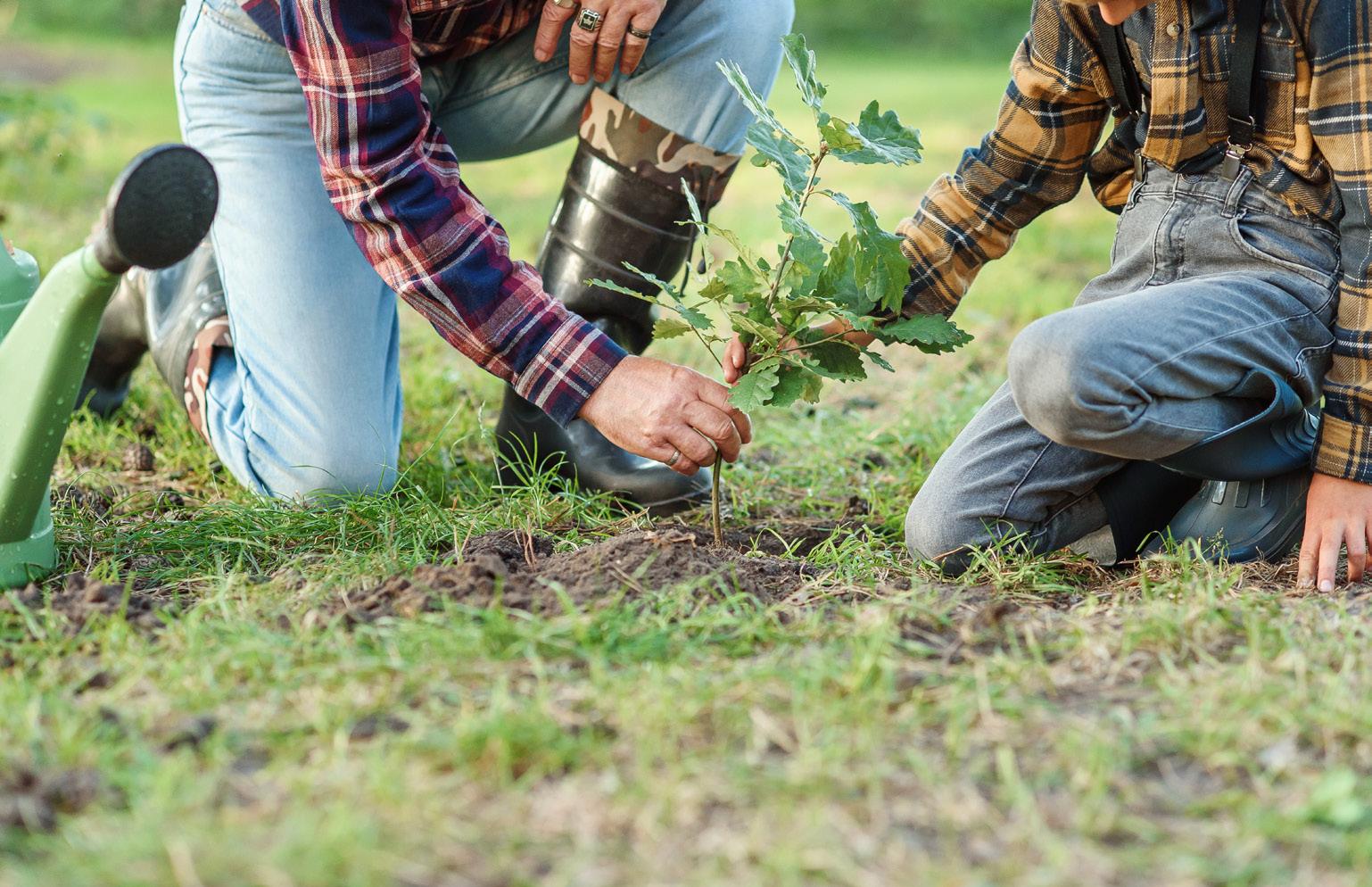

Jason Meyer | Executive Director
CRAFT SPIRITS: Were there any key gains for the White Oak Initiative in 2024?
Jason Meyer: The Initiative notched several successes in 2024, but perhaps the most prominent were the introduction of H.R. 5582, the White Oak Resilience Act, which passed as part of the Fix Our Forests Act, and the introduction of S. 5289, the White Oak Resilience Act of 2024. These legislative actions not only raise awareness with policymakers about the importance of white oak from an economic and ecological standpoint, but they also call for direct onthe-ground outcomes such as completion of pilot projects related to white oak restoration, increasing nursery capacity, landowner education and assistance and more. Beyond that, the Initiative has continued to support landowners, forest practitioners and more through educational opportunities and access to research related to how to effectively manage oak forests to ensure a sustainable supply of white oak for future generations.
What are the White Oak Initiative’s primary goals for 2025, and how are you addressing the challenges facing white oak sustainability?
Our mission is to be an advocate and catalyst for sustainable oak forest management with a focus on white oak regeneration. We accomplish this through convening, connecting and collaborating with stakeholders to increase the economic, social and ecological benefits of upland oak forests. In 2025, we are placing a major emphasis on identifying
existing partnerships and collaborations around the issue of white oak regeneration, as well as building those partnerships where they may not exist. Ensuring a bright future for white oak takes a combination of awareness, education, landowner support, research, funding and more. We aim to bring the right combinations of players to the table to form effective partnerships that can get the job done when it comes to managing our oak forests sustainably.
How is the Initiative working with forest landowners, cooperages, and distillers to ensure the long-term health of white oak forests?
The White Oak Initiative is in an interesting position—we don’t necessarily work directly with landowners, as much as we try to support those who do. Our industry partners like distillers, cooperages, and stave mills, are critical to our work related to crafting good public policy around oak management, whether it is on Capitol Hill or at the state and local levels. These partners inherently care deeply about the sustainability of this resource and are doing everything from funding boots-on-theground foresters to working with certification programs to develop standards to recognize sound hardwood management. And, of course, getting the message out to landowners that they must actively manage their land for white oak is important to all of us in the Initiative, so we are working collaboratively on developing the key messages behind that need.
How can the craft spirits industry better support the White Oak Initiative’s efforts in sustainable forestry and conservation? There are a number of ways that the industry can support our efforts, ranging from amplifying our message on social media, sponsoring and/or hosting regional meetings, providing operational funding and more. We also just built some policies and procedures around cause marketing that opens the door for industry partners to advertise their support of the White Oak Initiative by donating a percentage of their sales to our efforts. We’re excited to see where that goes.
What are the key messages or takeaways the initiative hopes to share with the public and industry stakeholders in 2025? This all boils down to the need to actively and appropriately manage our upland oak forests. This requires ongoing work, ongoing financial investment, ongoing research, and the faith and understanding that while the work we do today may not be fully recognized for 80 years, it is good and necessary work. White oak requires sunlight to grow, and without actively managing our forests so that sunlight reaches the forest floor, our forests are converting to other species that survive better in the shade. It’s a tough nut to crack, but the more we all promote the idea that active forest management is the solution to the white oak regeneration issue, the better our odds are of ensuring that landowners have the resources they need to successfully regenerate white oak on their properties. ■
BY MAGGIE BOYD

Imagine this … you have the perfect product, of course, and you have interest from a distributor in another state, and those sales will make your month. Your eyes light up. You can make ends meet this month because now your product is ready to be sold to the new state, right? Maybe. This article will explain the step-by-step process of how to get your product to market in a new state.
The first step is licensing. Of course, you are already licensed as a distiller in your home state, but the state where you are selling to may also require a permit and brand registration. For distilled spirits products, as we all know, each state is either “open” or a “control” state. In the simplest of terms, an open state is where the supplier sells directly to a licensed wholesaler in that state. A control state is where the supplier must sell directly to the state and the state sells the product via its own retail stores or to licensed wholesalers in the state.
This article is going to focus on the compliance process with open states. The first step, after having a distributor in place, is to determine what type of license is required. As noted, most open states require some type of out-of-state supplier license. The application is usually pretty simple but does require disclosing the names of officers and directors of the company and some, like Colorado and Florida, even require fingerprints. Another item that many forget is that some states, like Illinois and Florida, require registration with the Secretary of State as a foreign entity and/or registration with the state’s department of revenue.
Another type of license to consider is a salesperson license. Most states, if a person will be actively selling products in the state
to licensed wholesalers/retailers, require a salesperson license. This application will either need to be completed by the out-ofstate supplier or some states, like Georgia and Washington, D.C, require the person to register as the applicant.
After the license is in process, determine if the state you are looking to sell to requires brand registration. Brand registration is typically completing a small application about the product you wish to sell in the state and providing the federal Certificate of Label Approval. Most states have moved the applications online and approval can be anywhere from instantly to up to 90 days. Once approved, brand registrations typically must be renewed on an annual basis and if a label changes, a label revision may be required as well.
Another matter that must be considered prior to selling the product is price posting. Several states, such as New York and Minnesota, require the prices to be submitted to the state. Some states require a monthly price posting, like New York (for certain licensees), others only require submission when a price has changed and some require annual postings. Price postings consist of a form that must be completed that lists the products and the price of the product(s) in the state. For instance, in New York, there is the supplier to wholesaler and then wholesaler to retailer price postings.
Phew. Now that you have received all the licenses to sell, successfully completed brand registration and price posting requirements, let’s sell! One last item to consider is whether the state requires monthly shipping reports. These are typically excise tax forms that must be submitted once a month that
The first step, after having a distributor in place, is to determine what type of license is required.
include the number of products you have sold into the state in the previous month and to whom the product was sold. These forms are typically simple. The hardest part is often remembering the due date every month, so be sure to set a calendar reminder for yourself or compliance team.
This list is not comprehensive but includes most items to consider when selling distilled spirits products to a distributor in a new state. Always review the requirements on the relevant state alcoholic beverage control/ division website to determine any and all compliance requirements for selling. ■

This article is for information and education purposes only and not intended to be specific legal advice of Malkin Law PA. Maggie Boyd has been a compliance specialist in the alcohol industry for nearly 18 years and is currently senior compliance specialist at Malkin Law PA (malkin.law).

Quench your thirst for knowledge in ACSA’s Craft Spirits Classroom. For more information or to register, visit our website at americancraftspirits.org/education/webinars.
An internship experience that is a STEP above the rest.
Partnering with member distilleries and wholesalers throughout the United States, we provide a comprehensive training program and provide job exposure for those of different races, color, national origins, genders, and sexual orientations.
